
























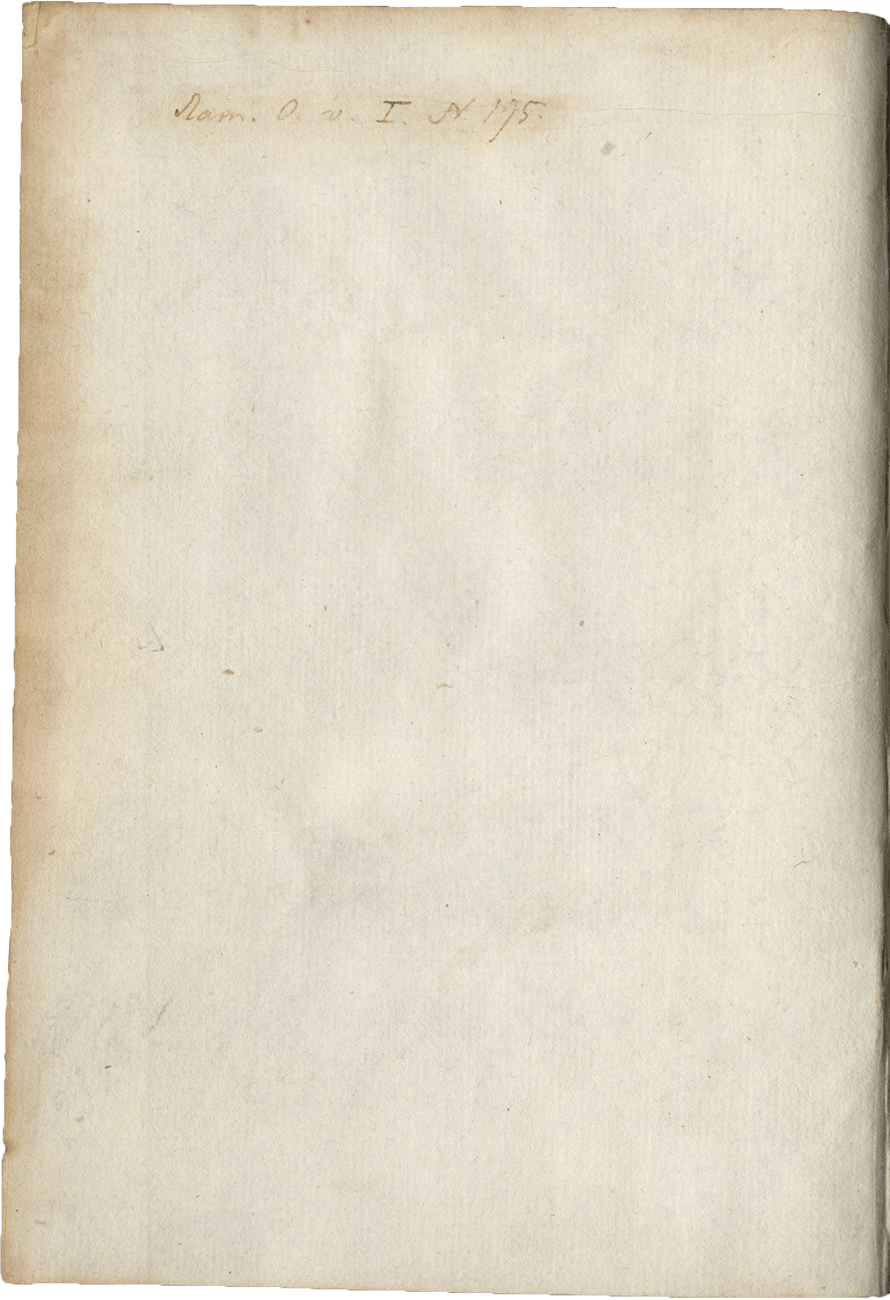
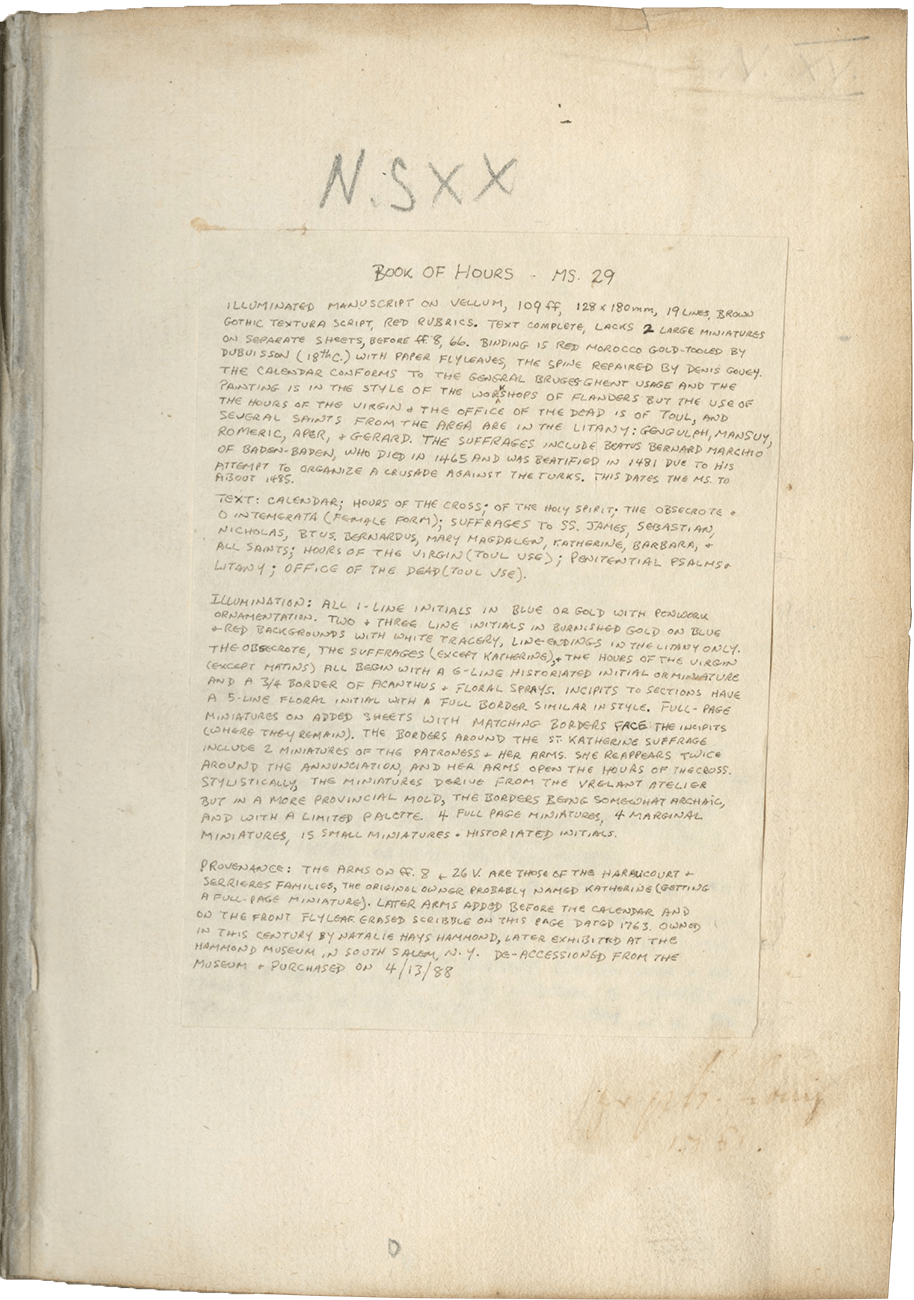

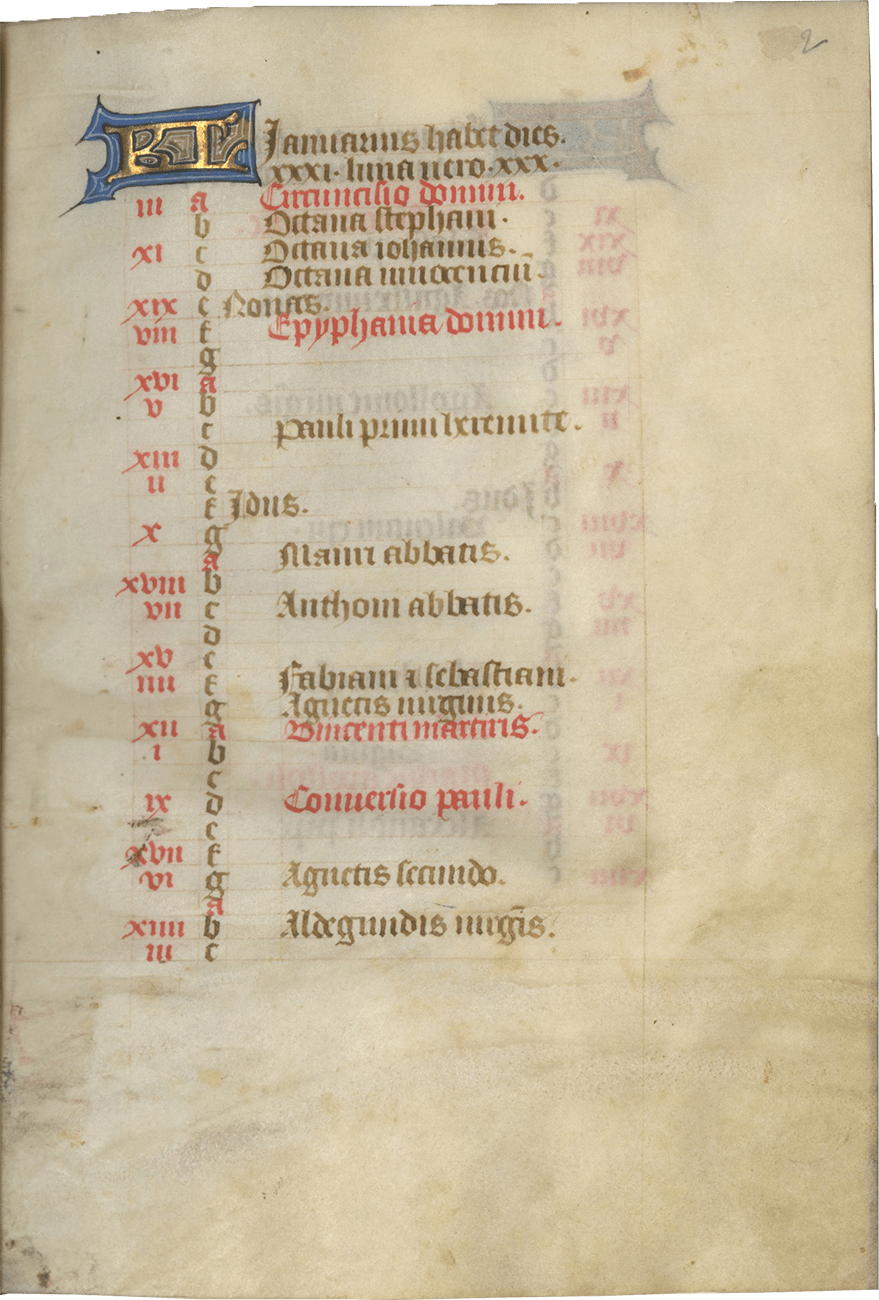
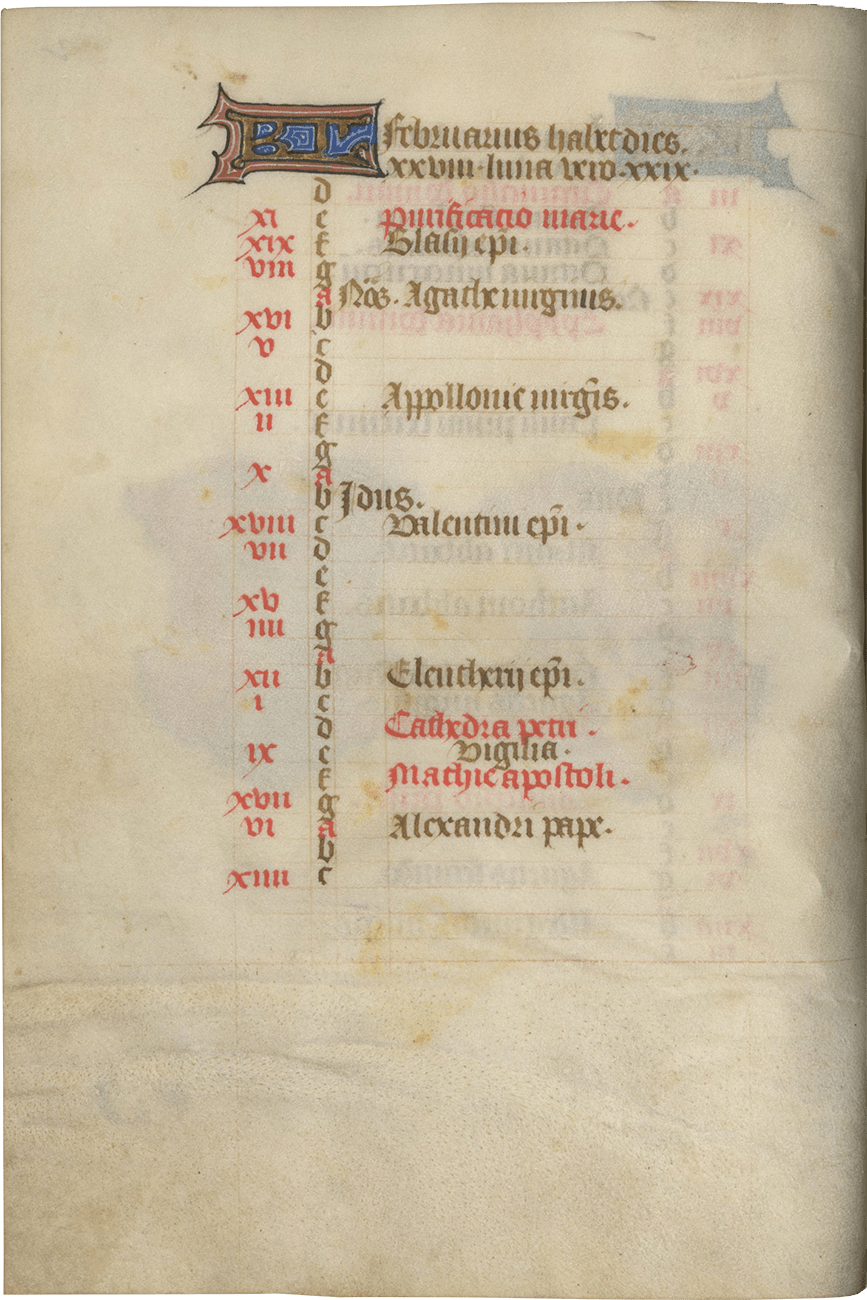
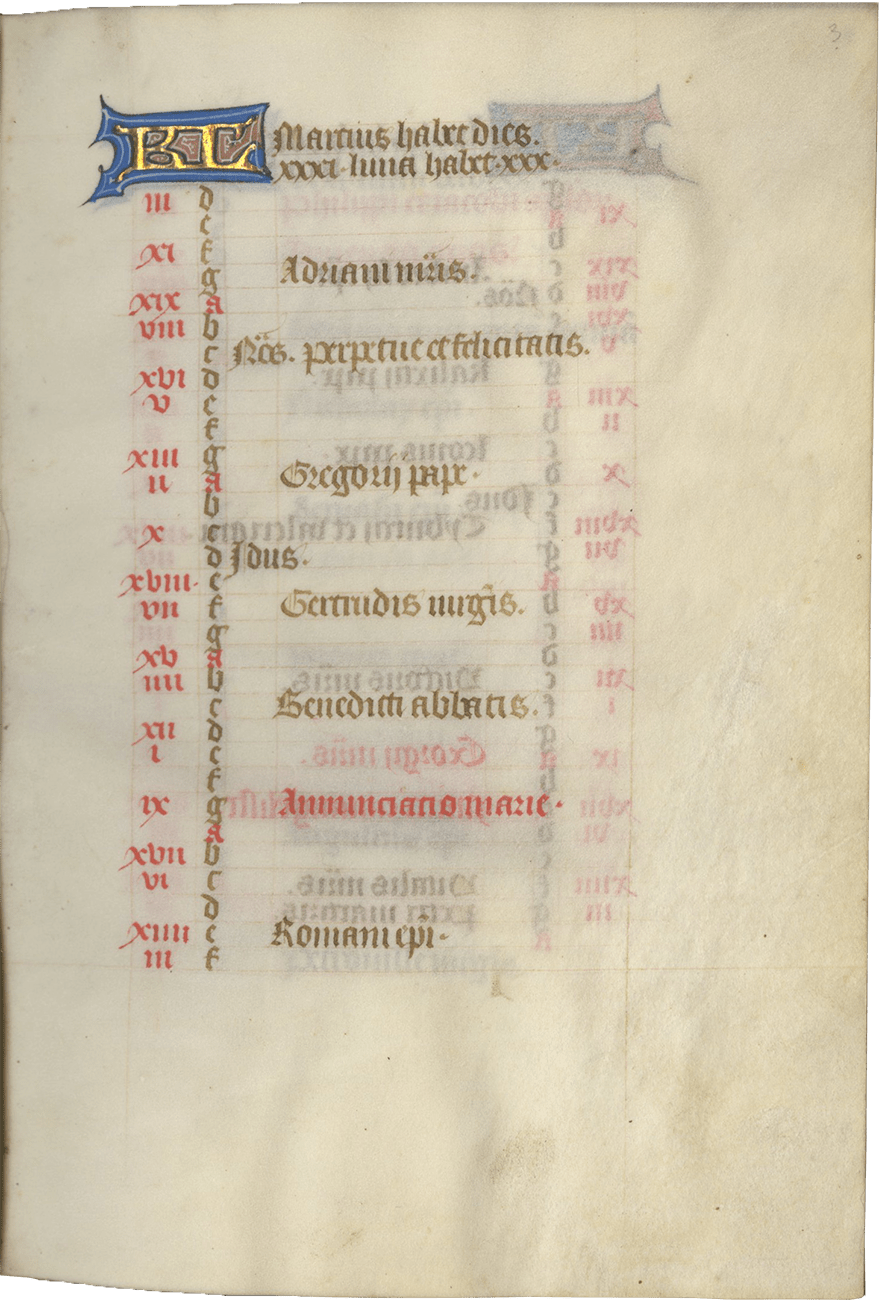
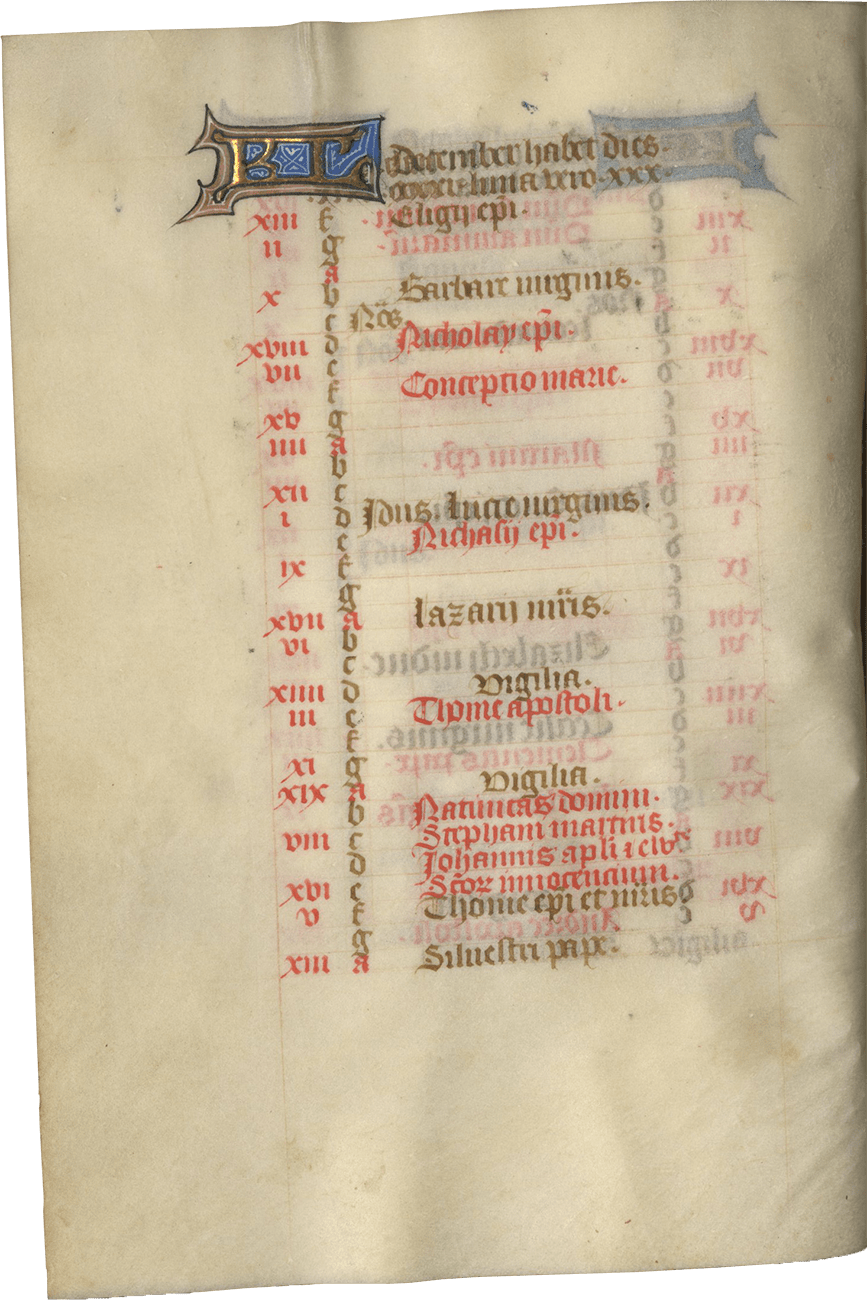
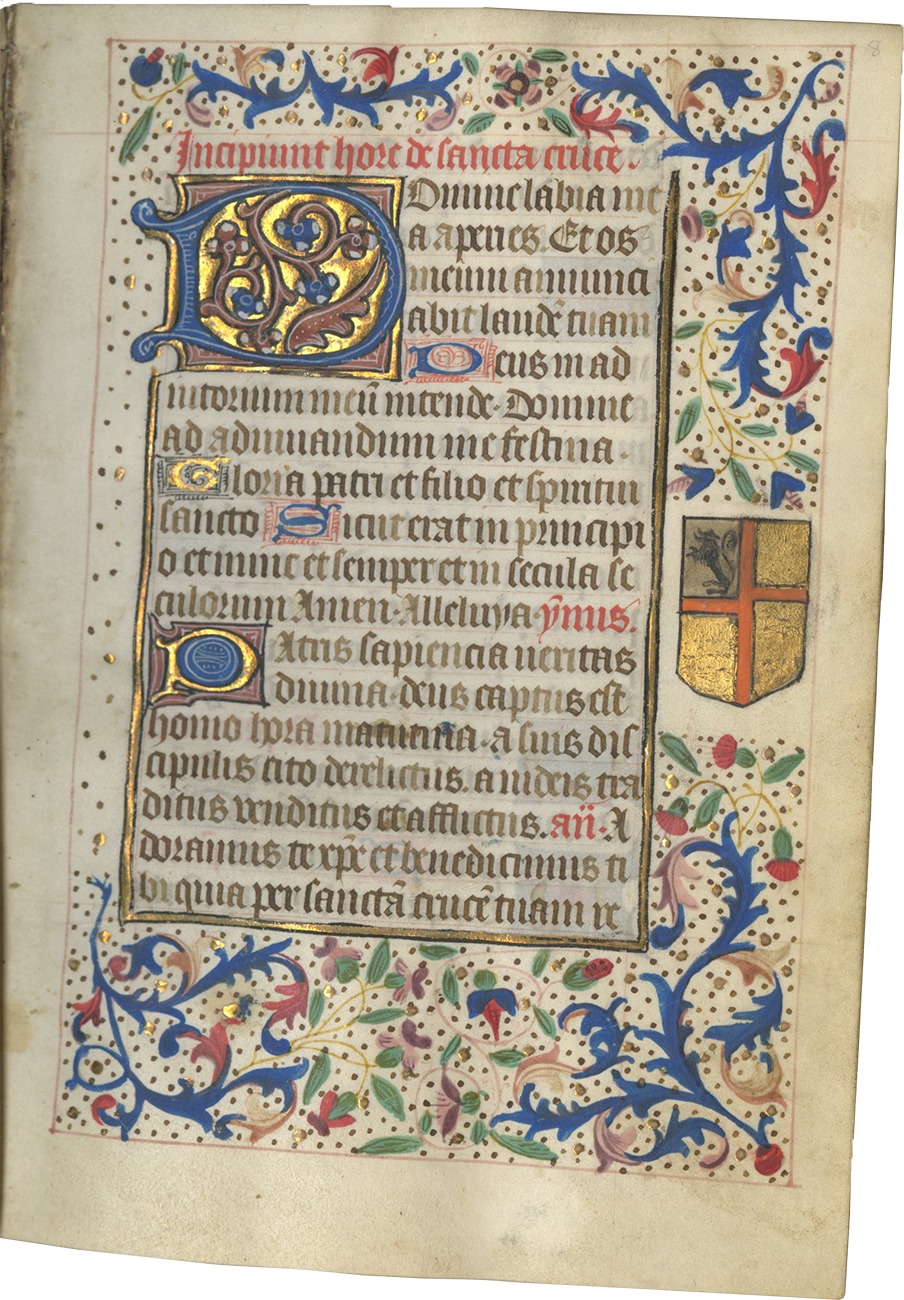

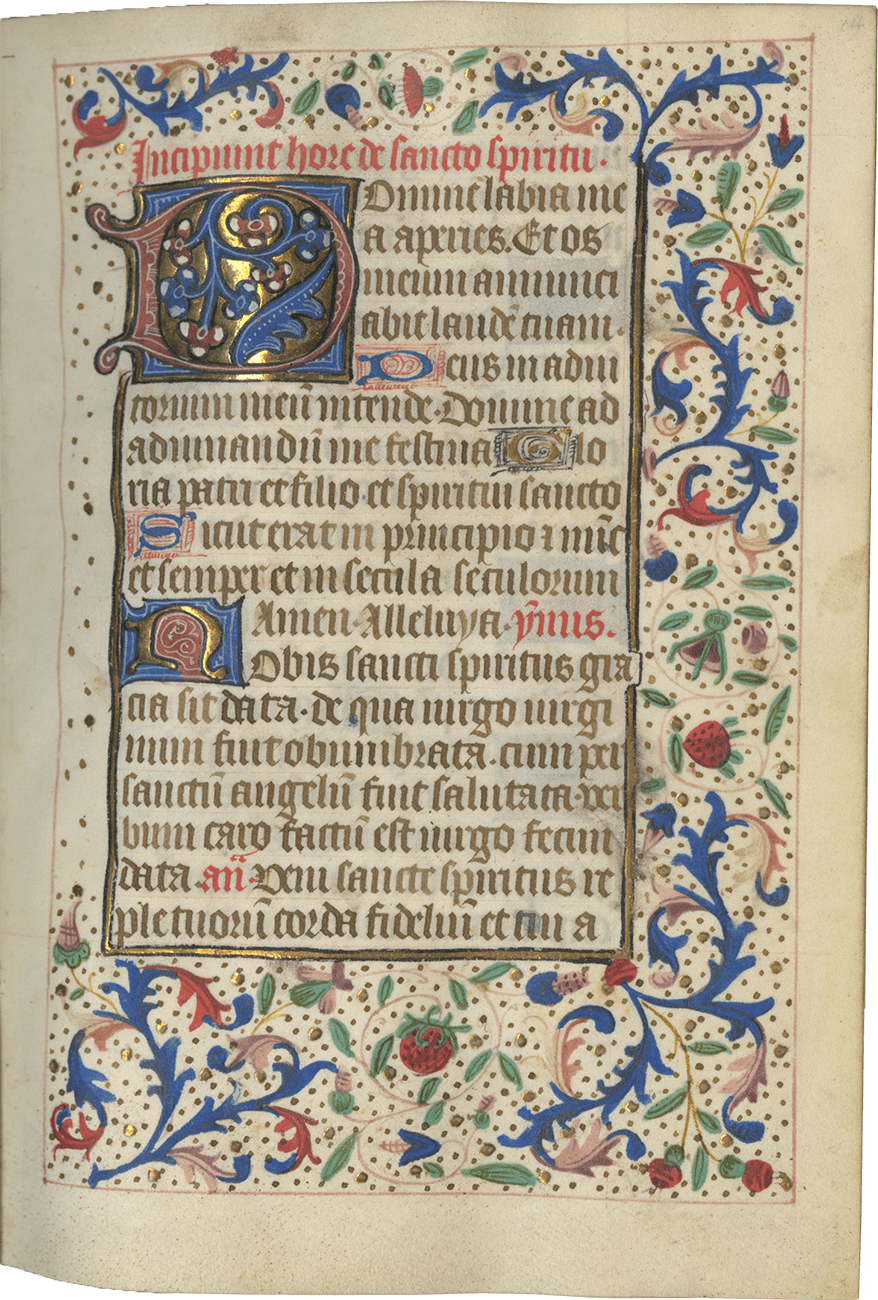
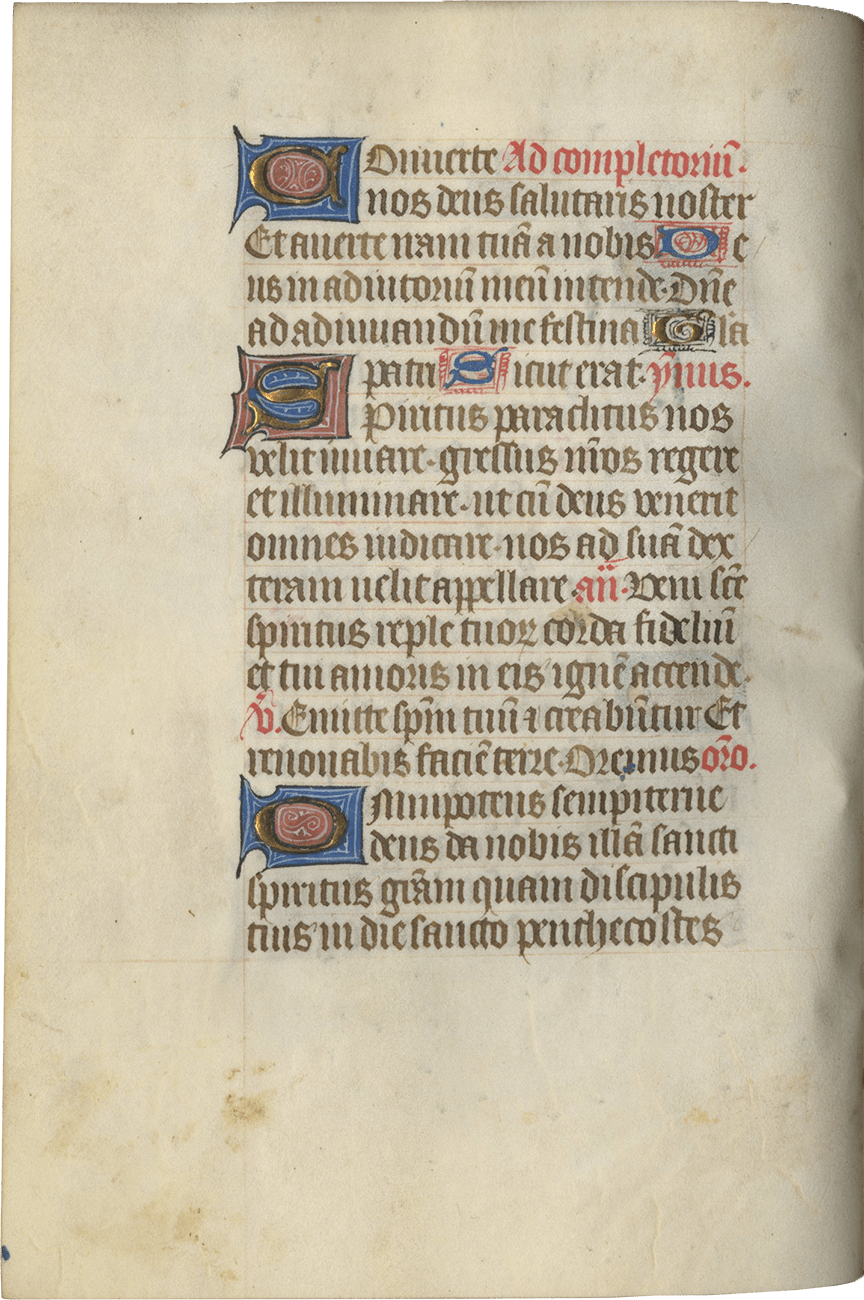
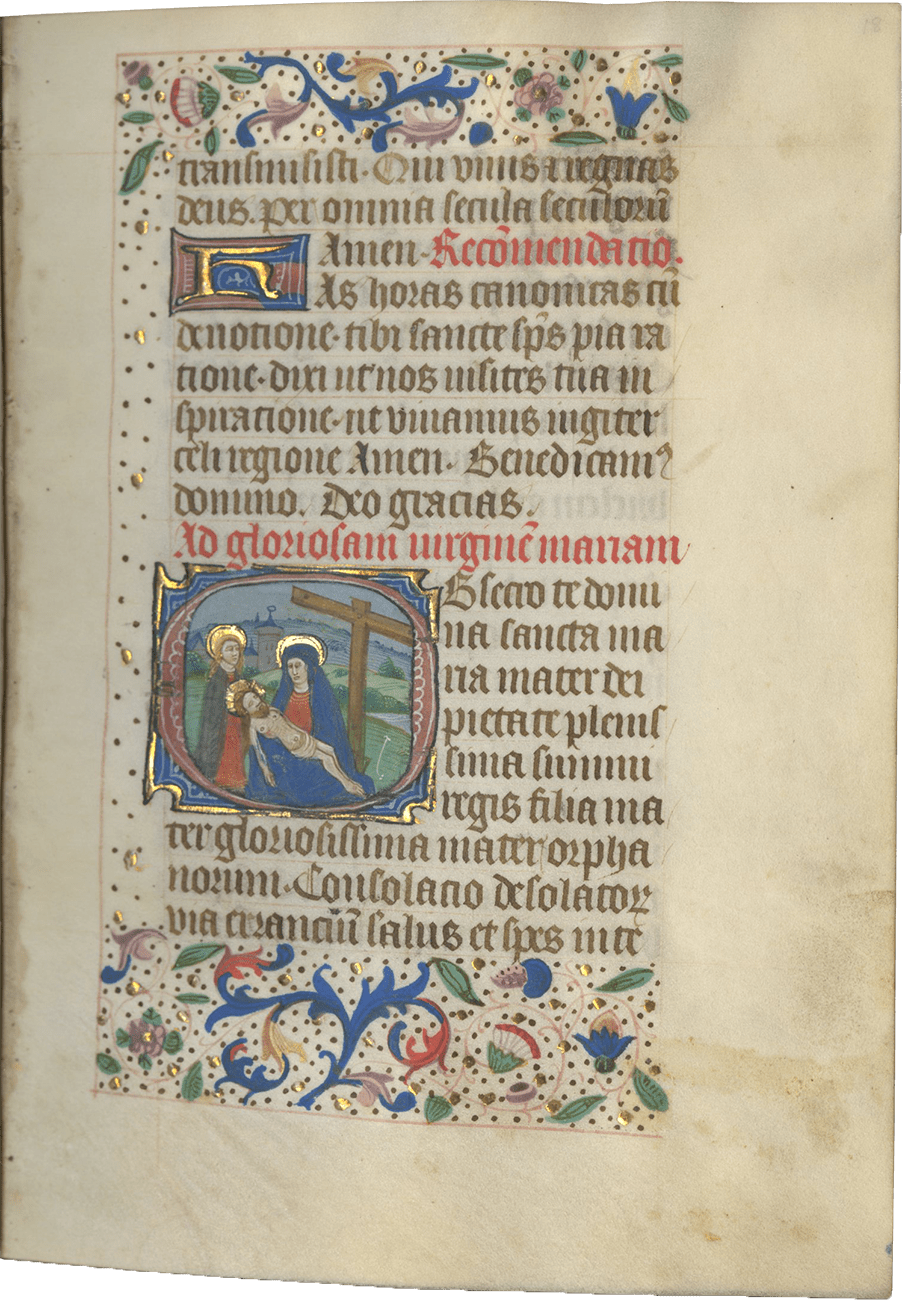
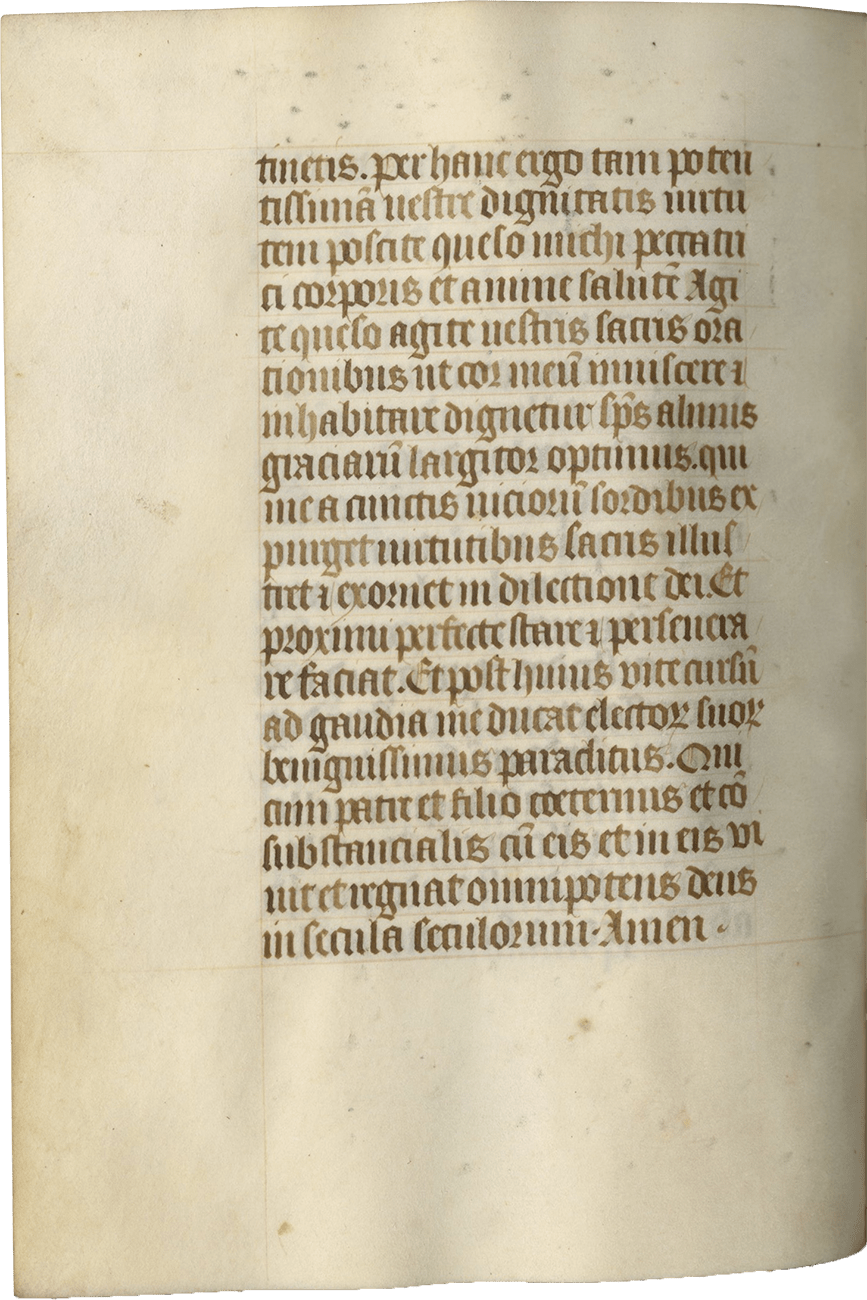

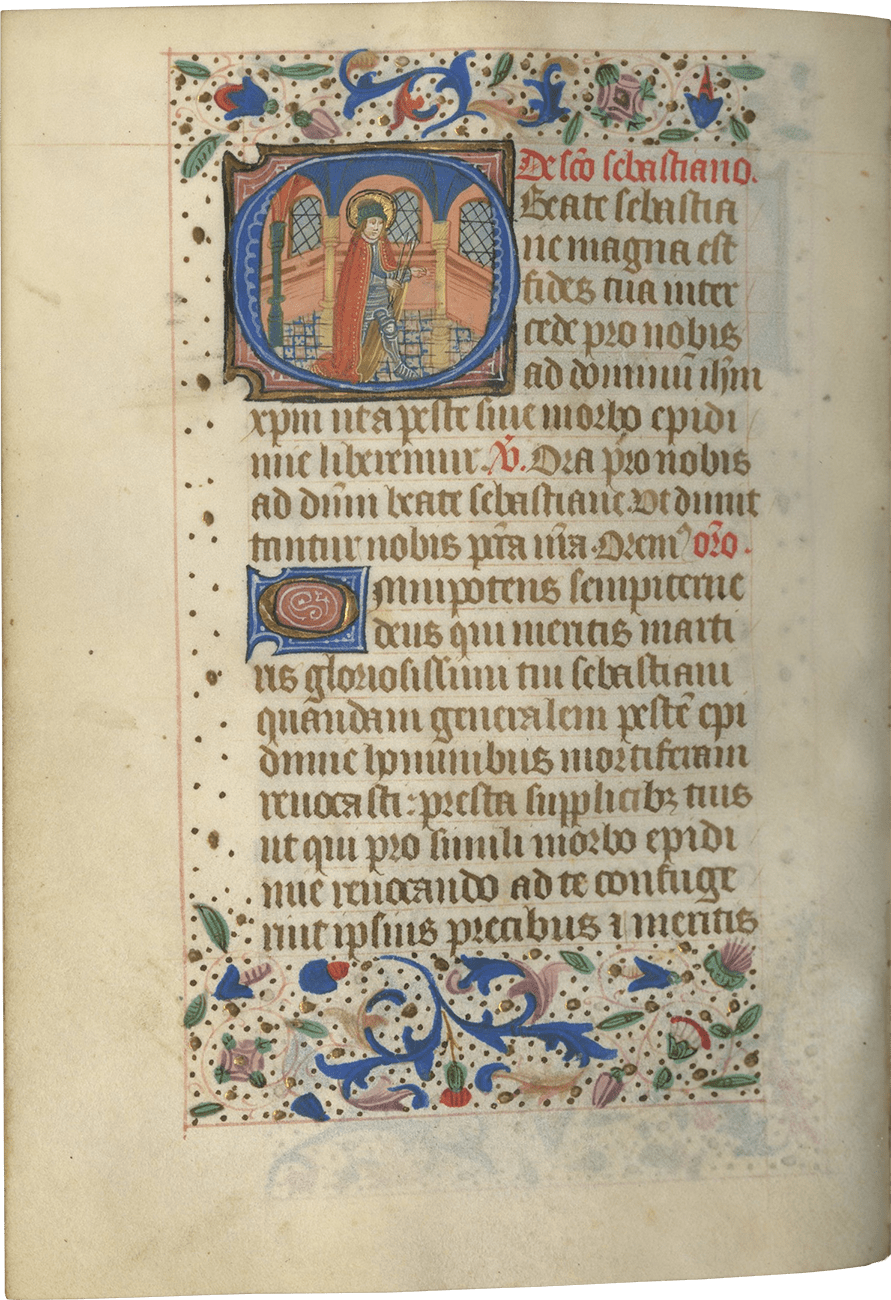


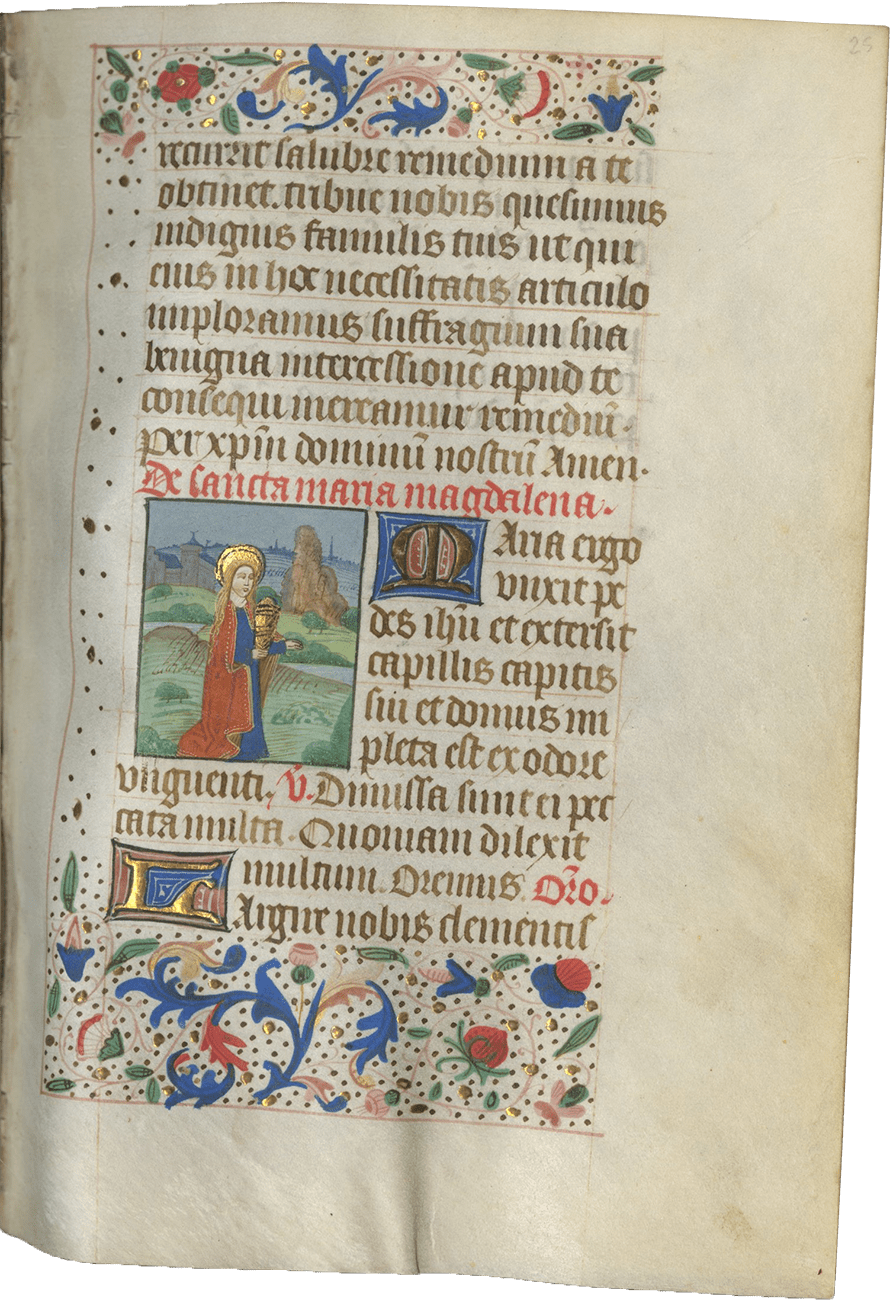
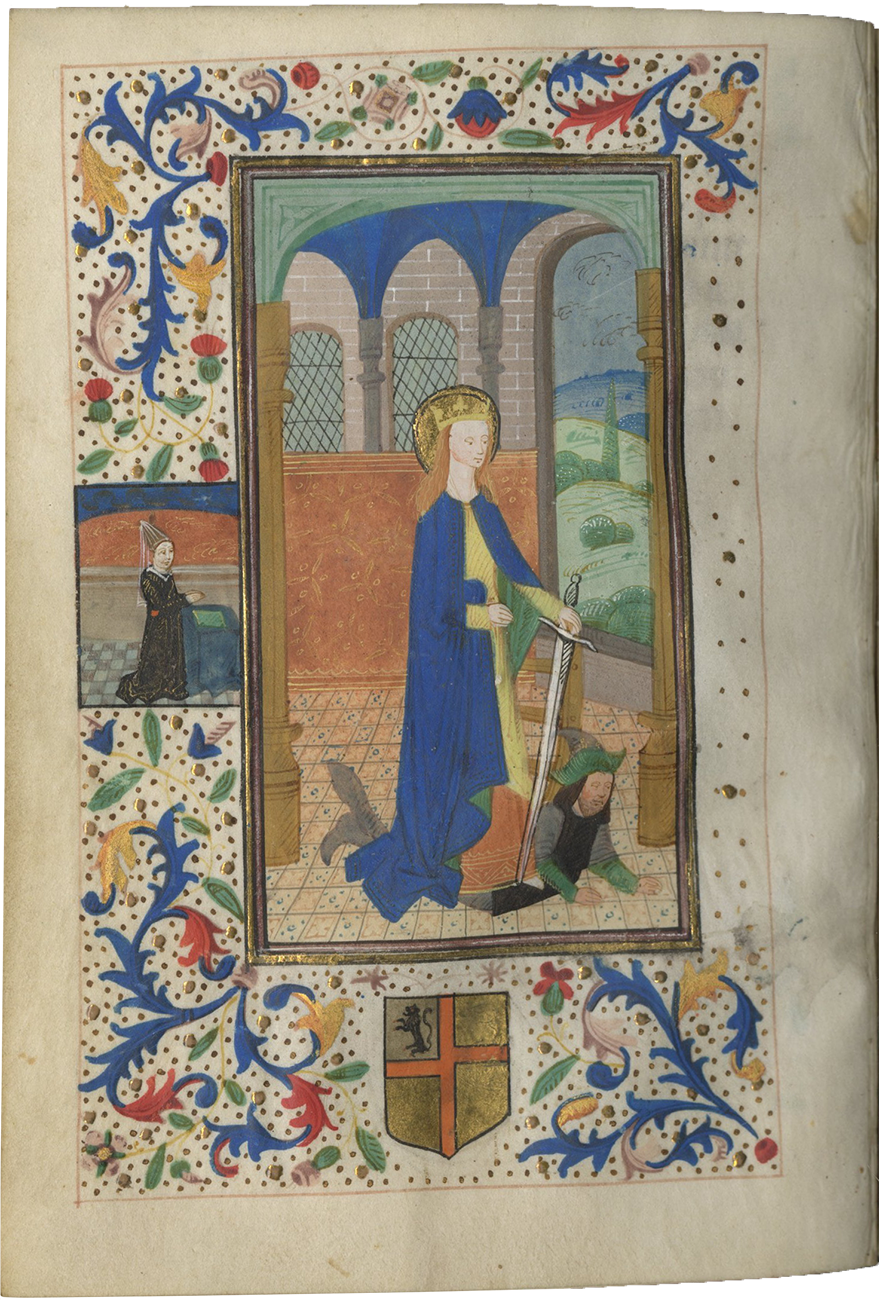

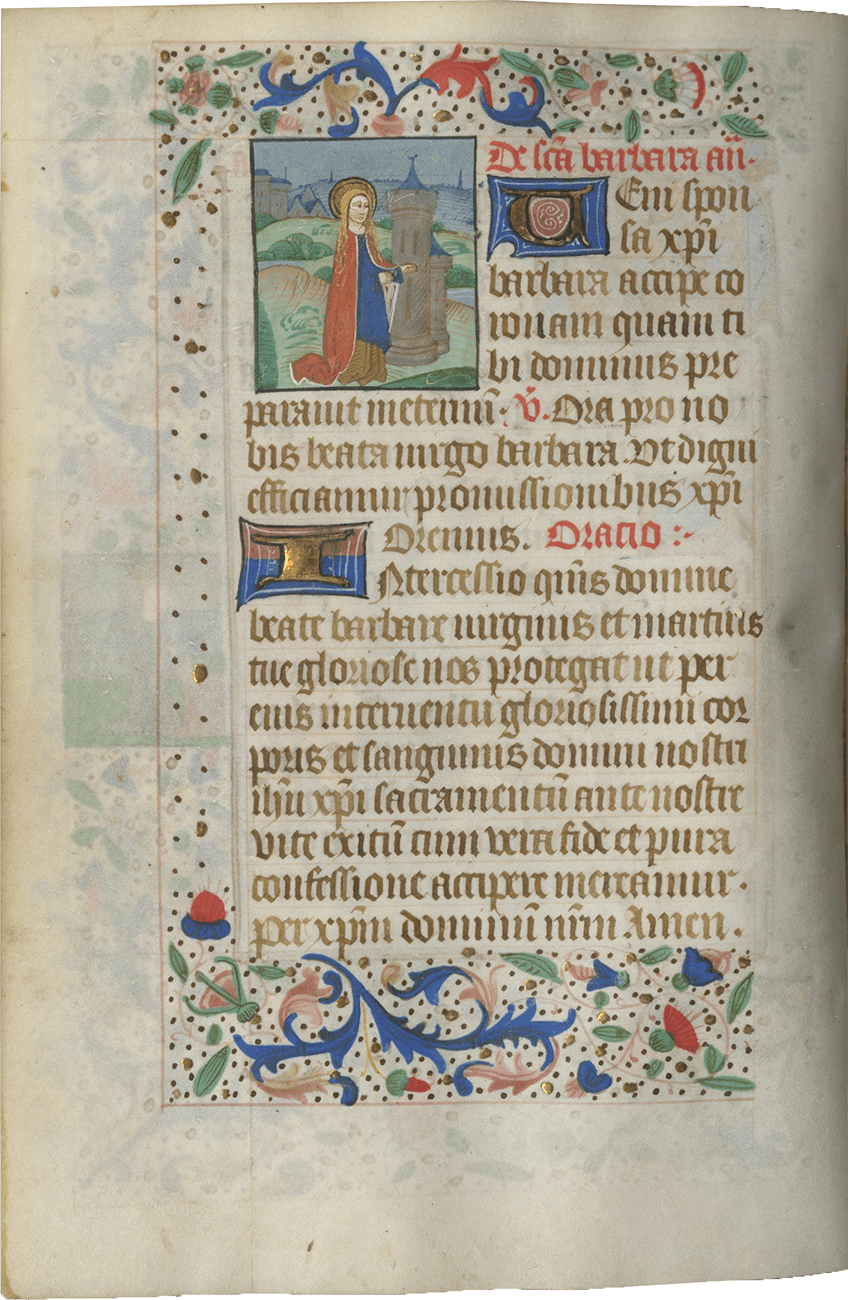

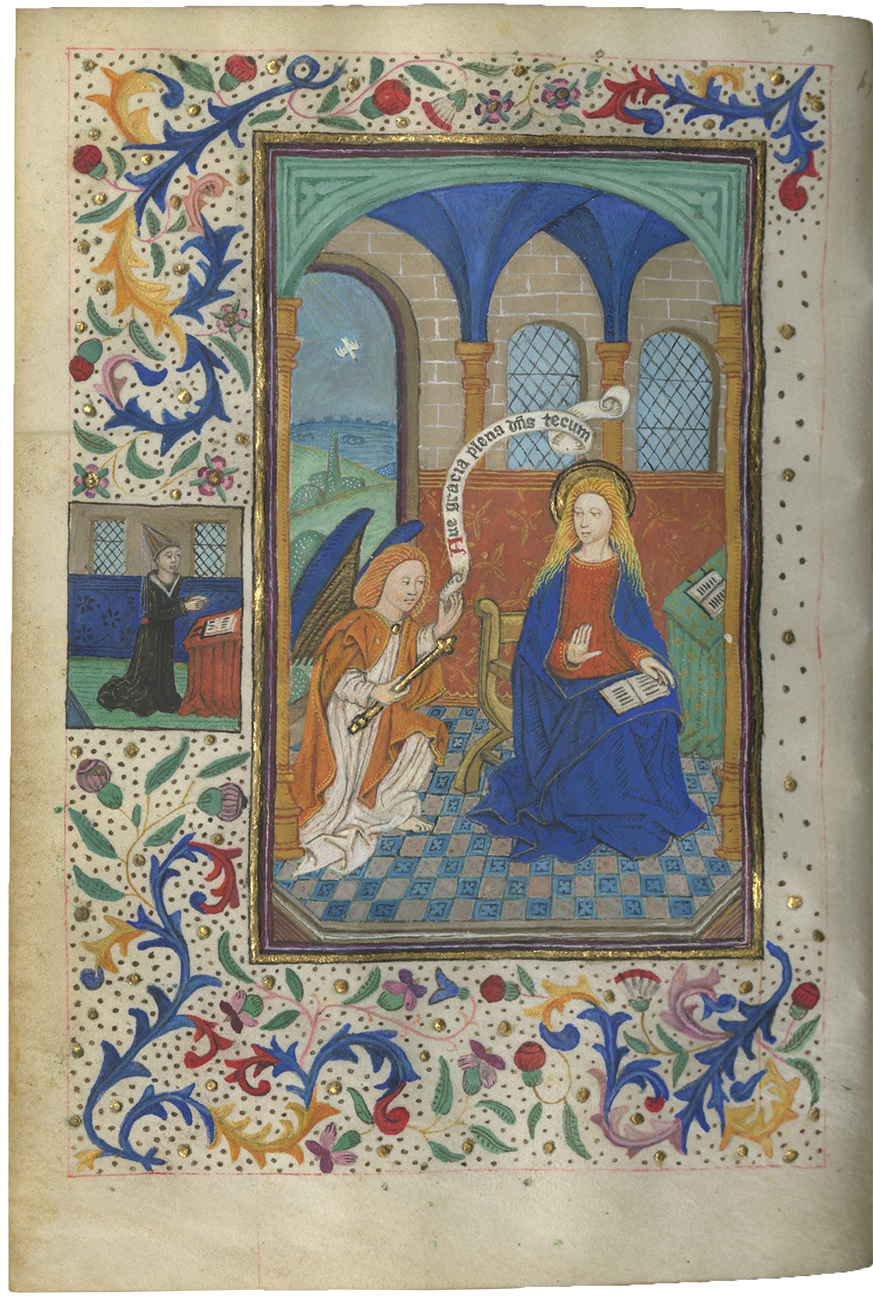
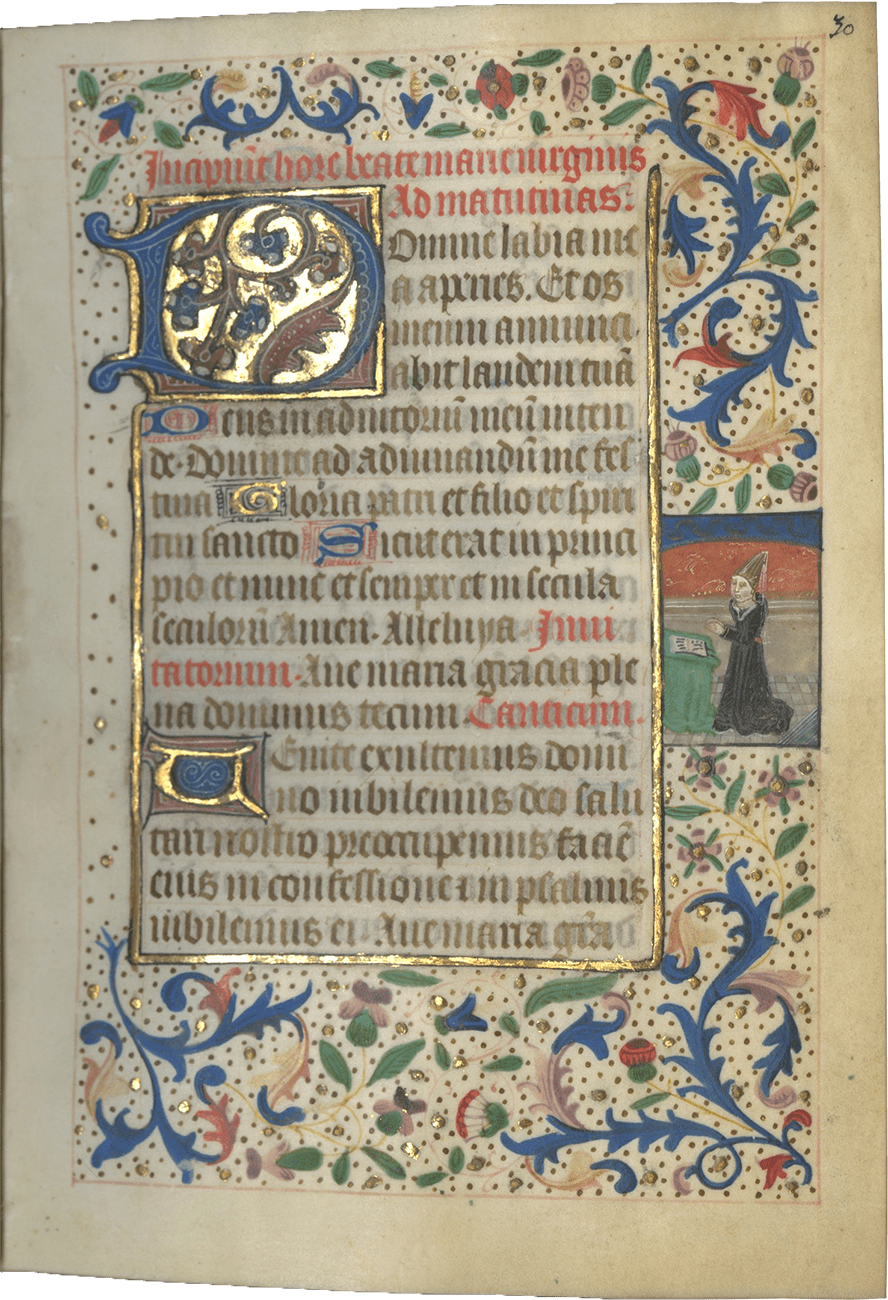
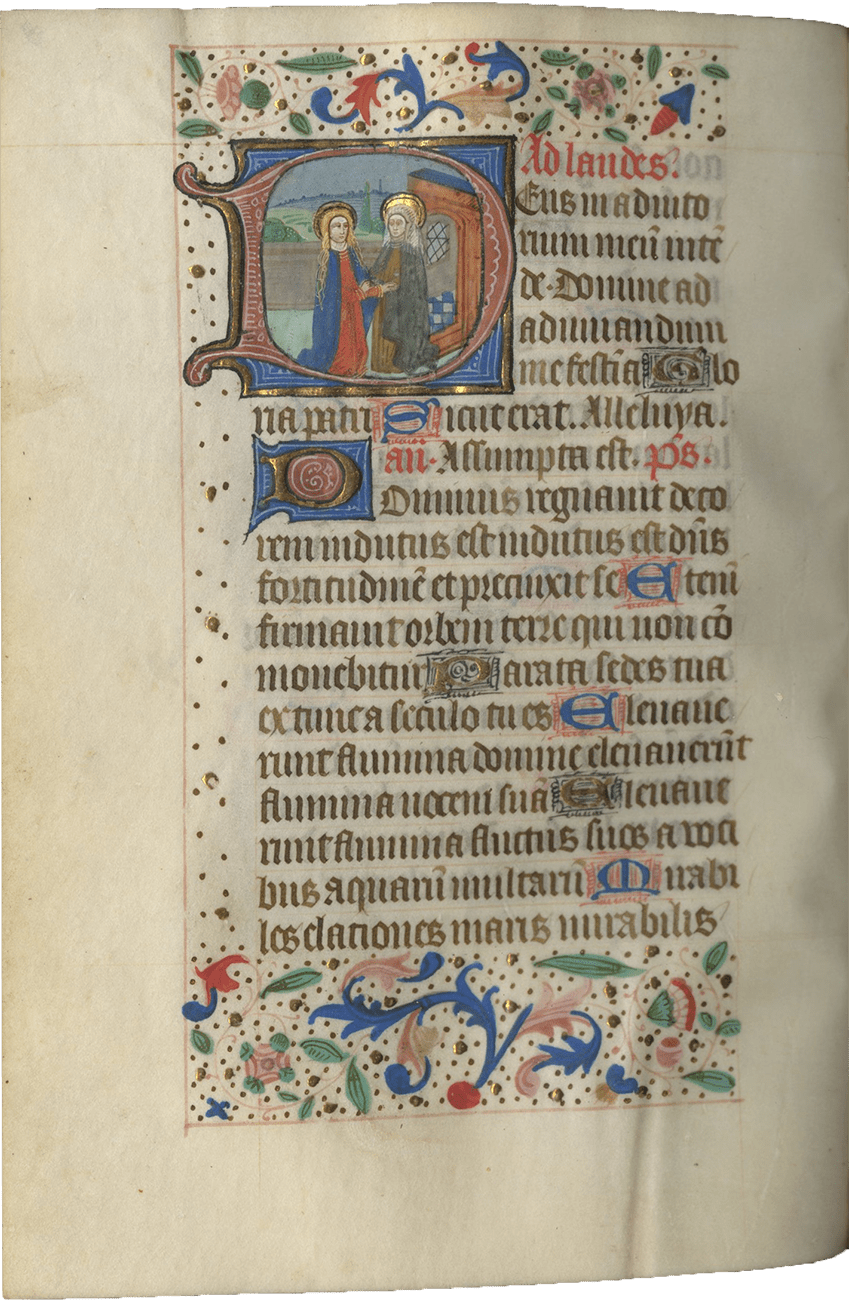
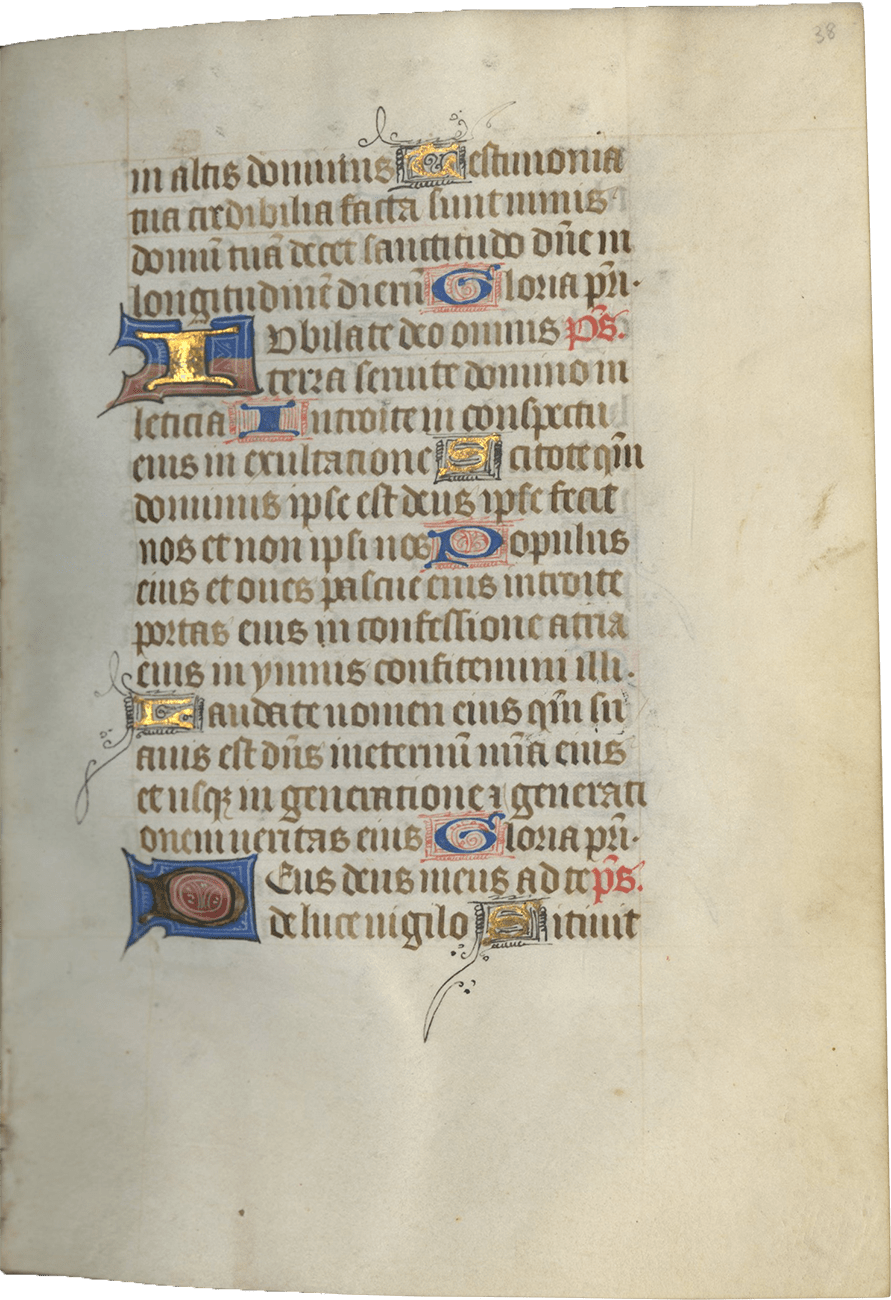
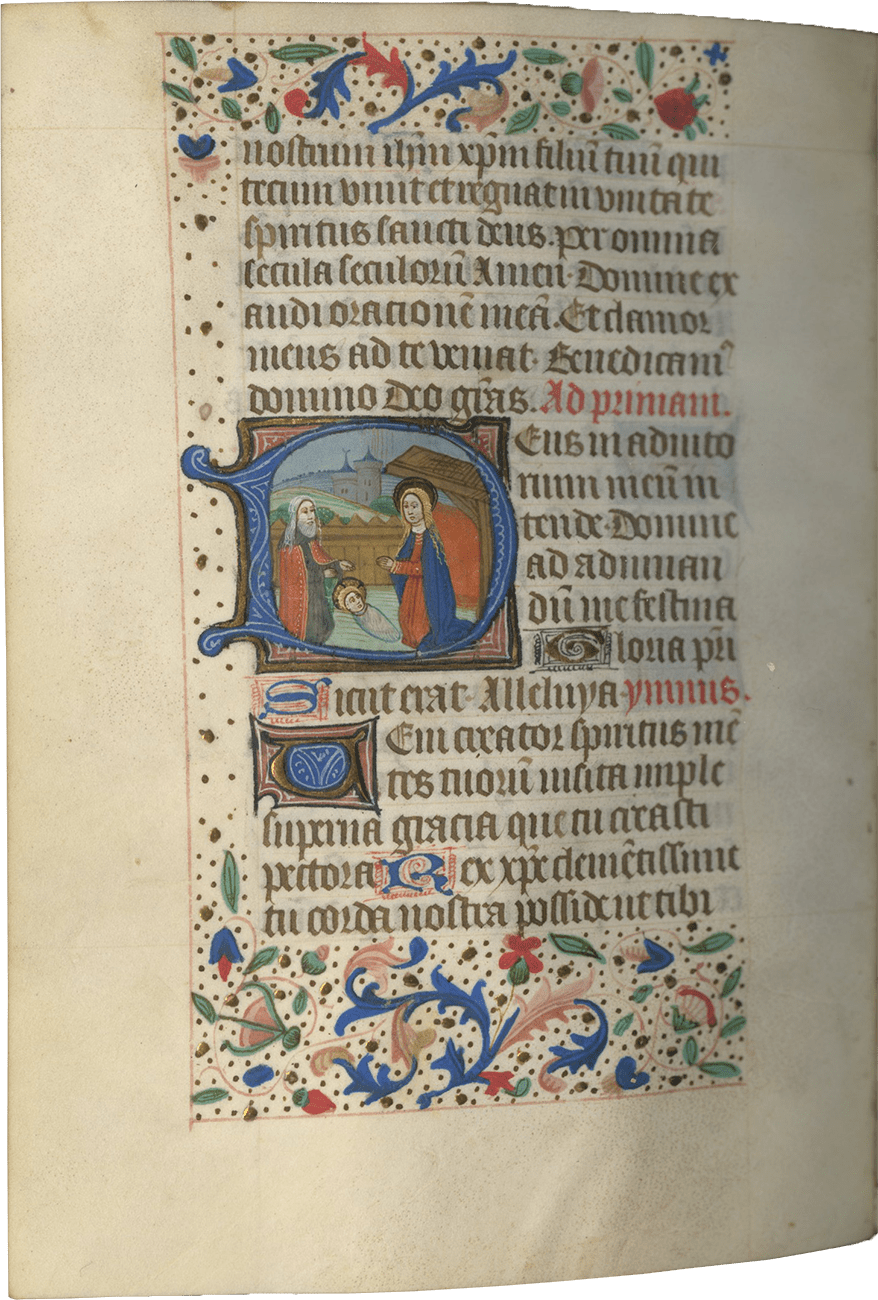

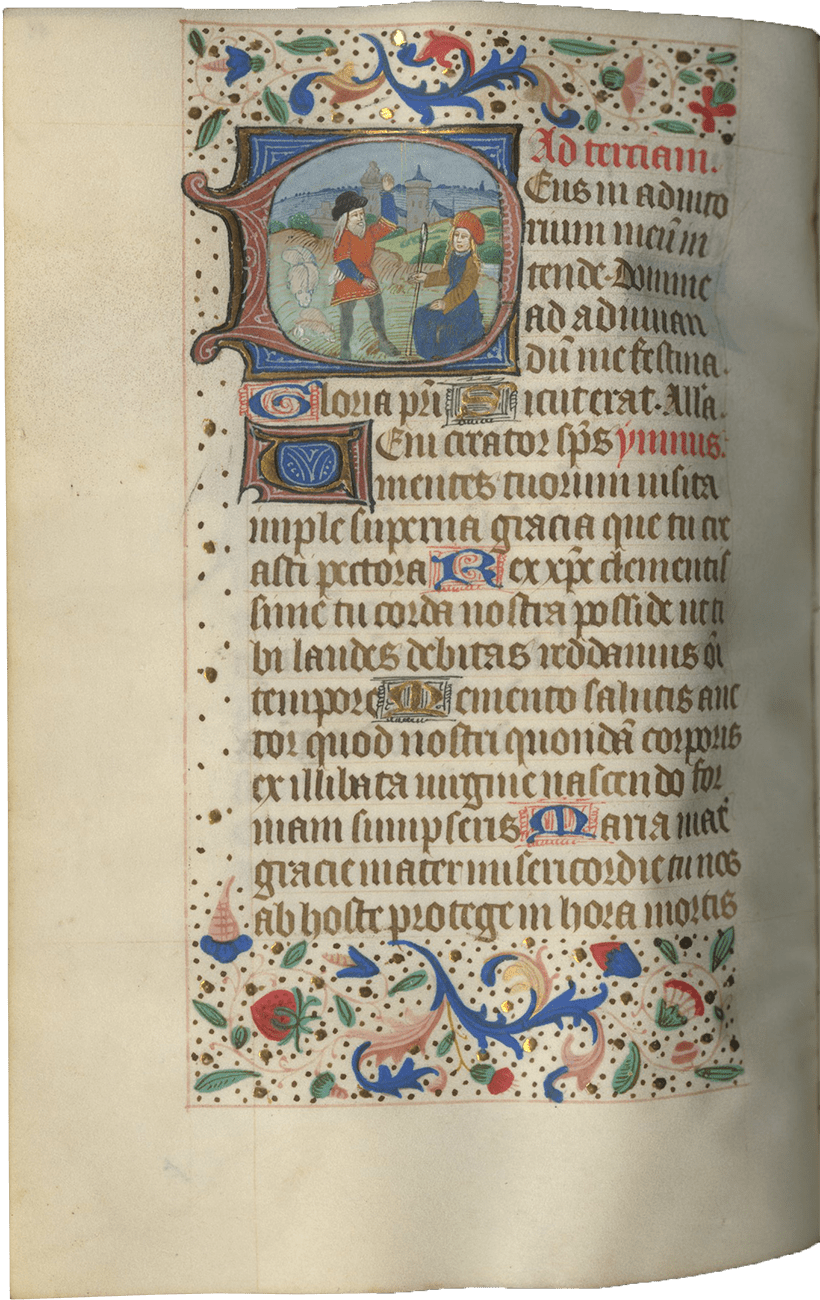
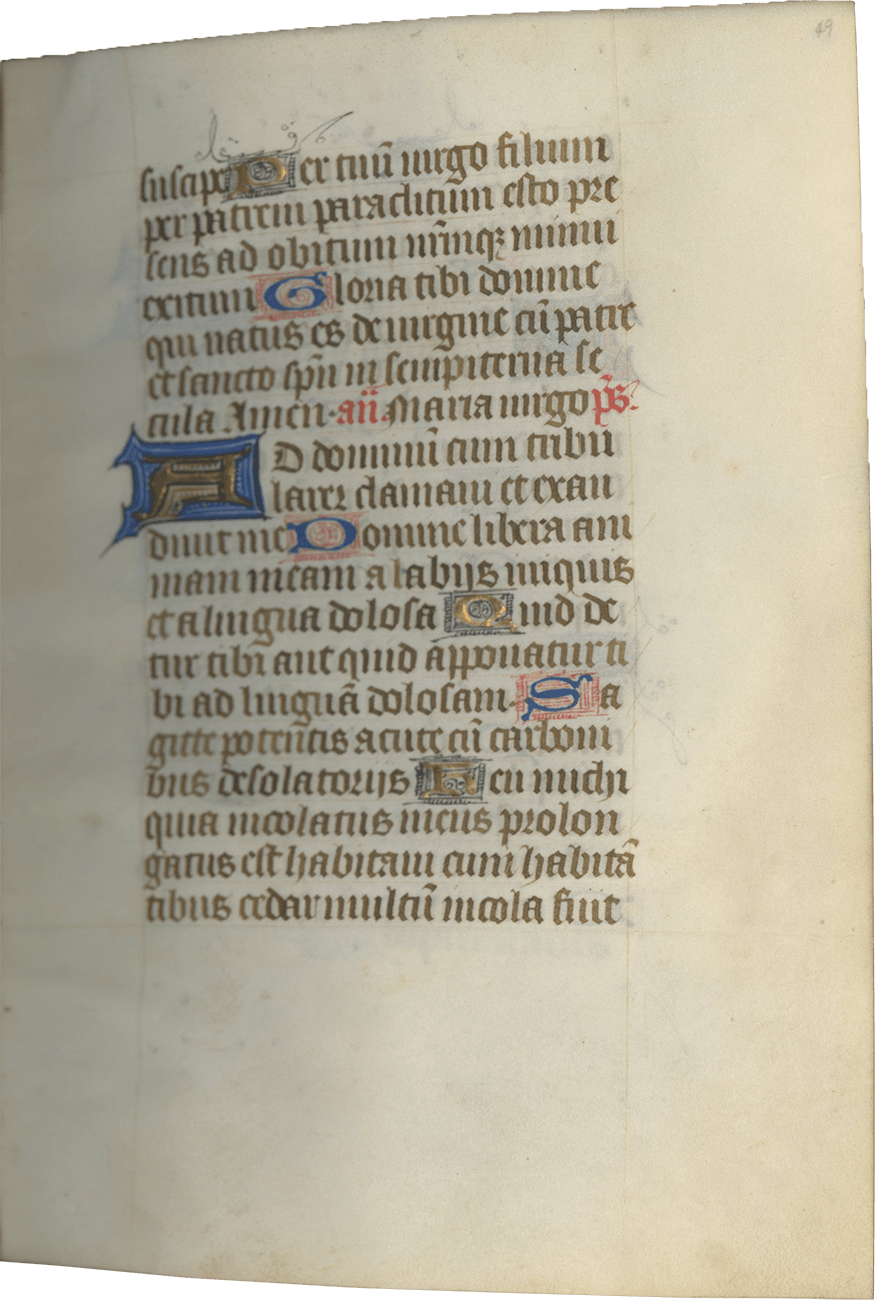
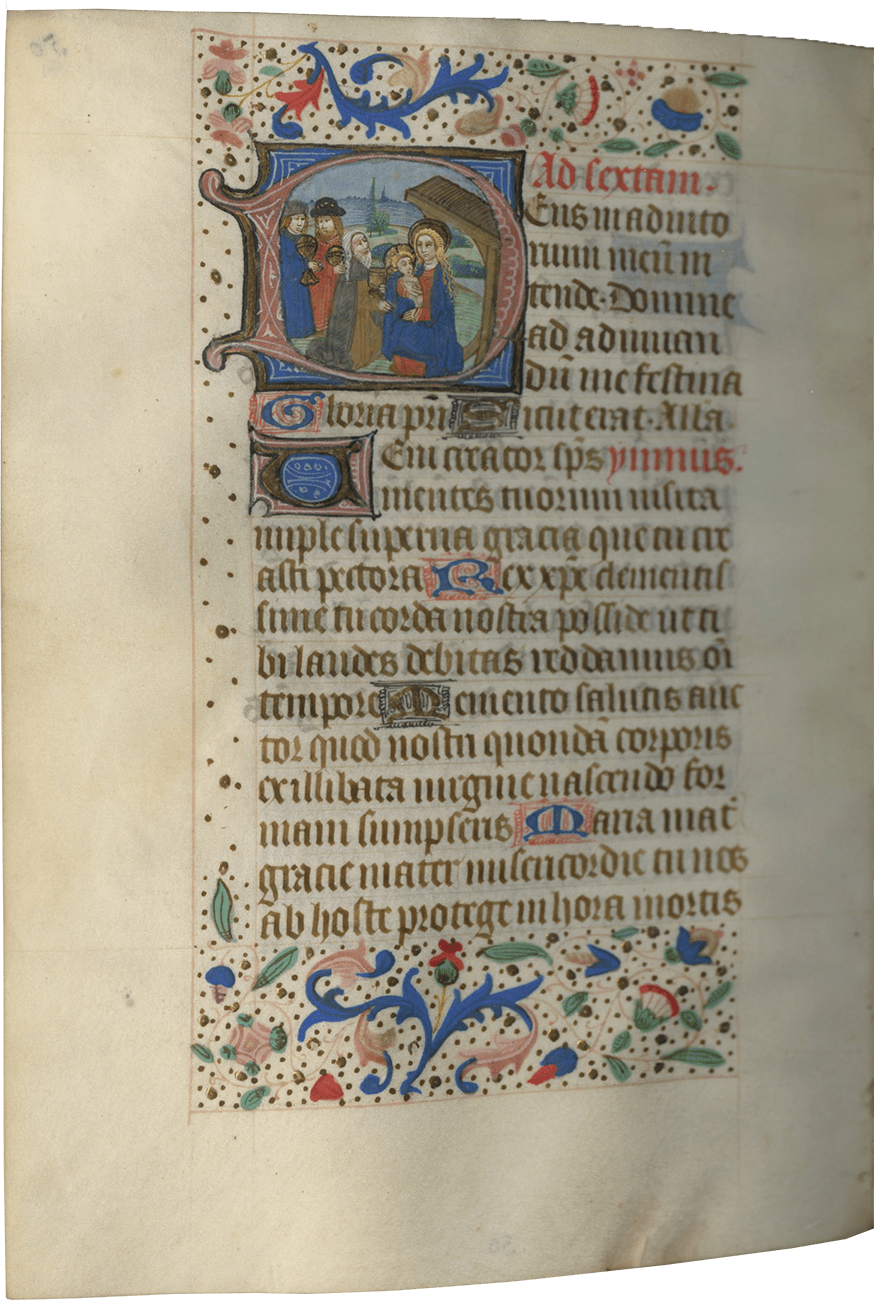
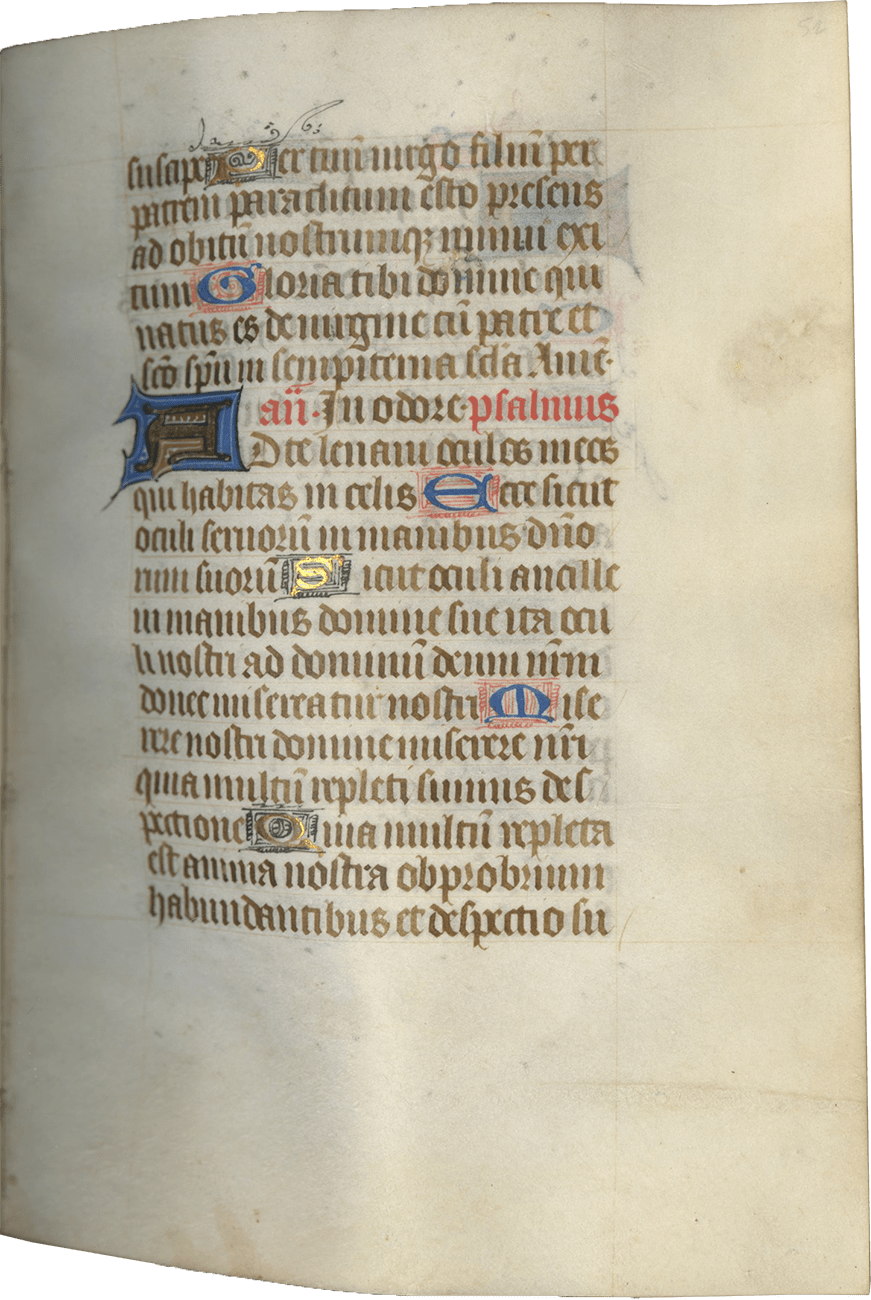


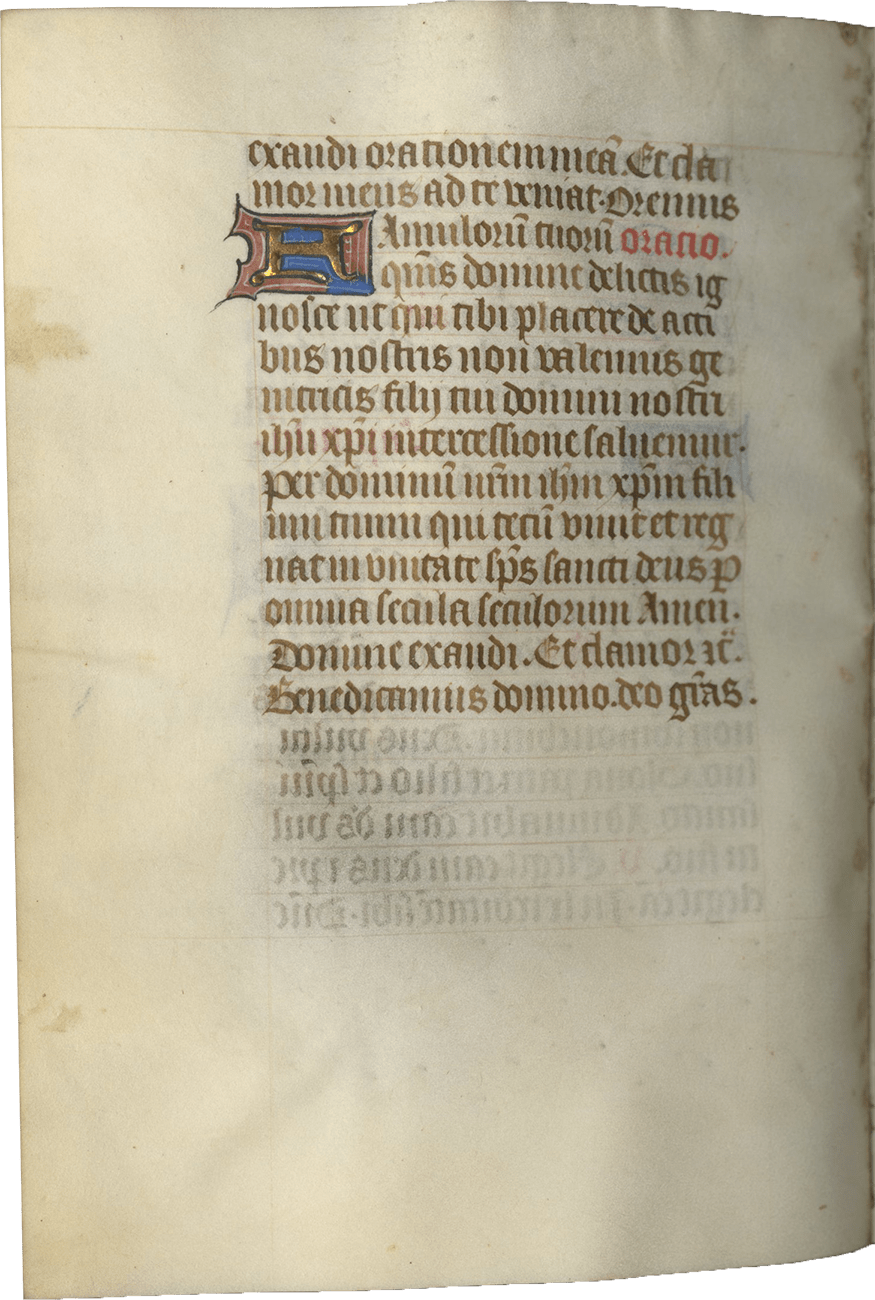
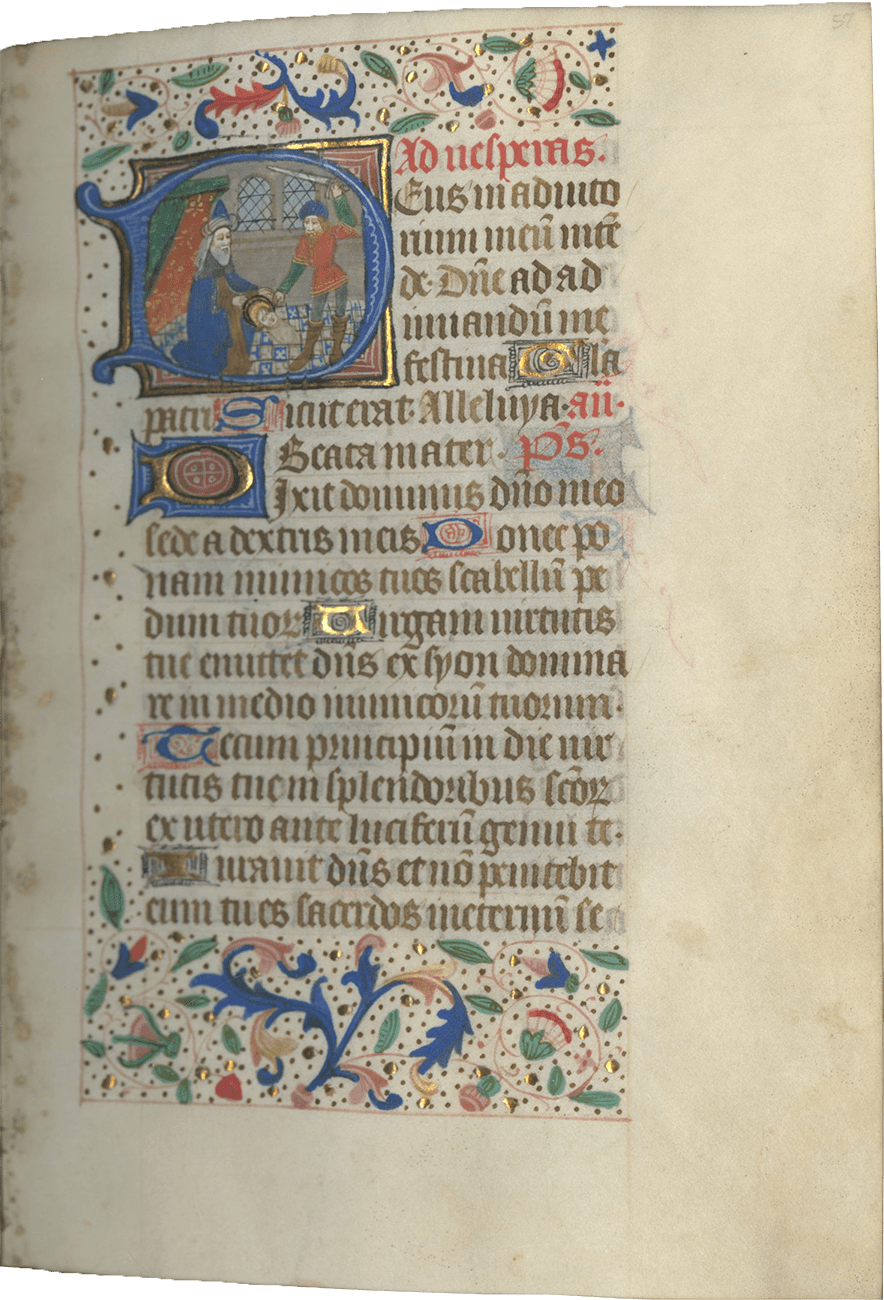

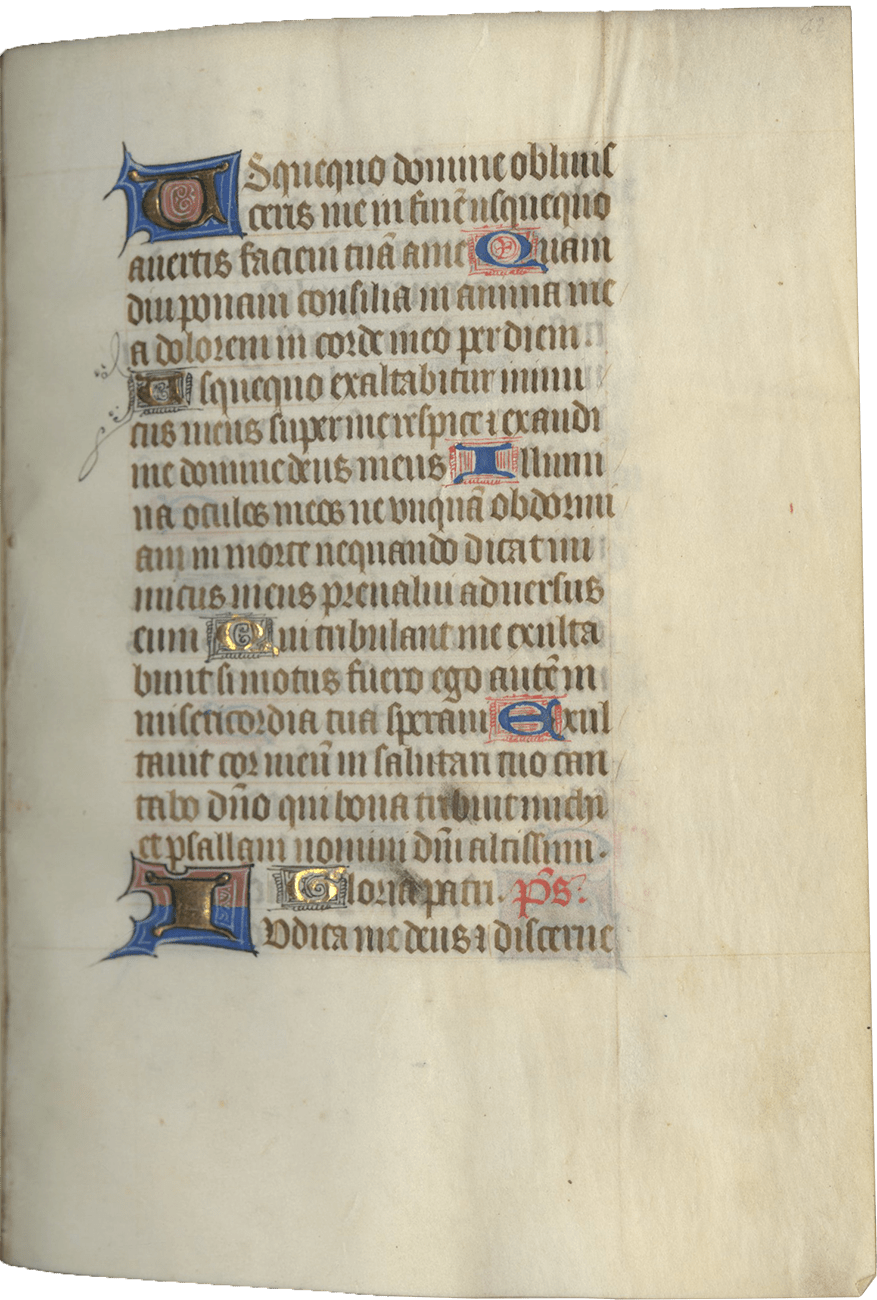
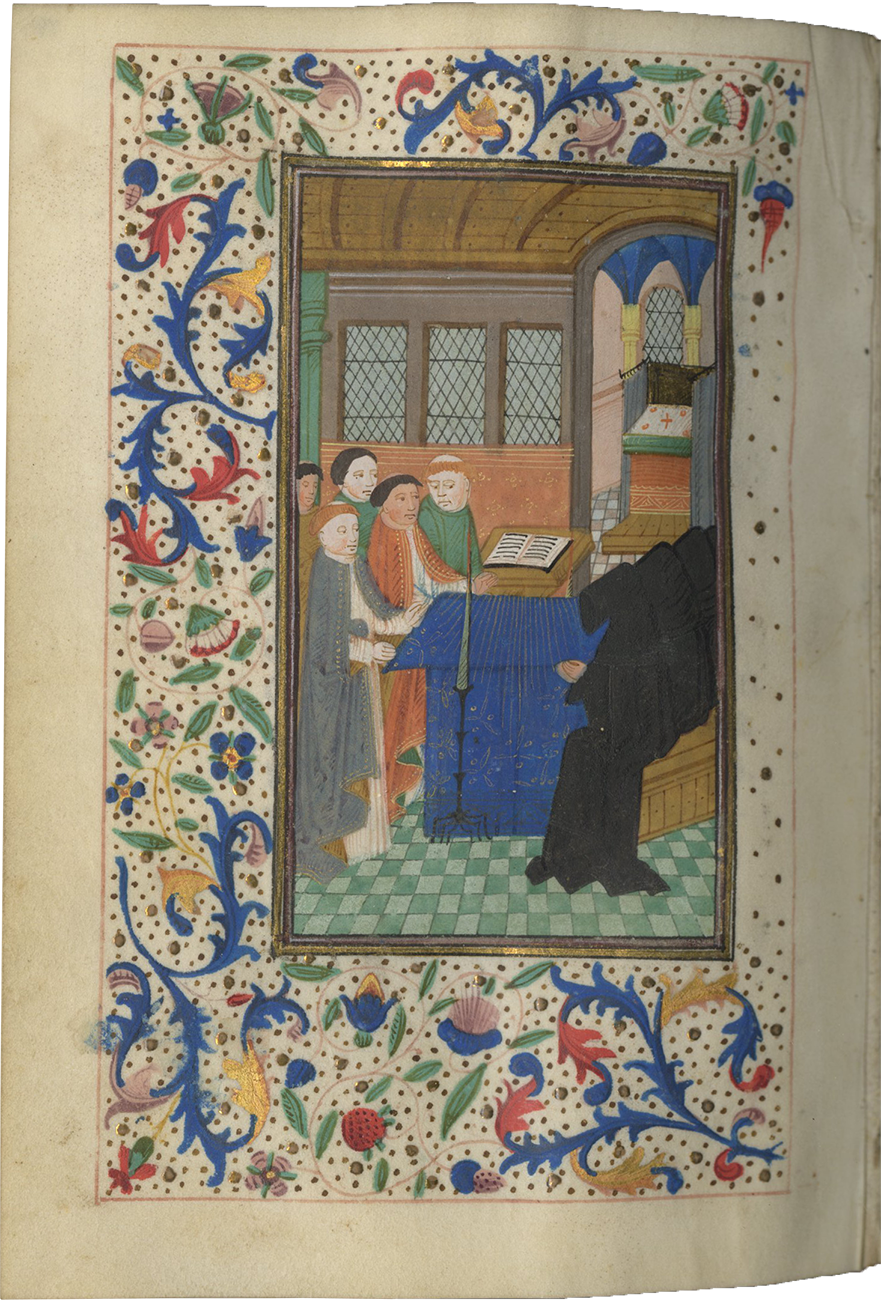

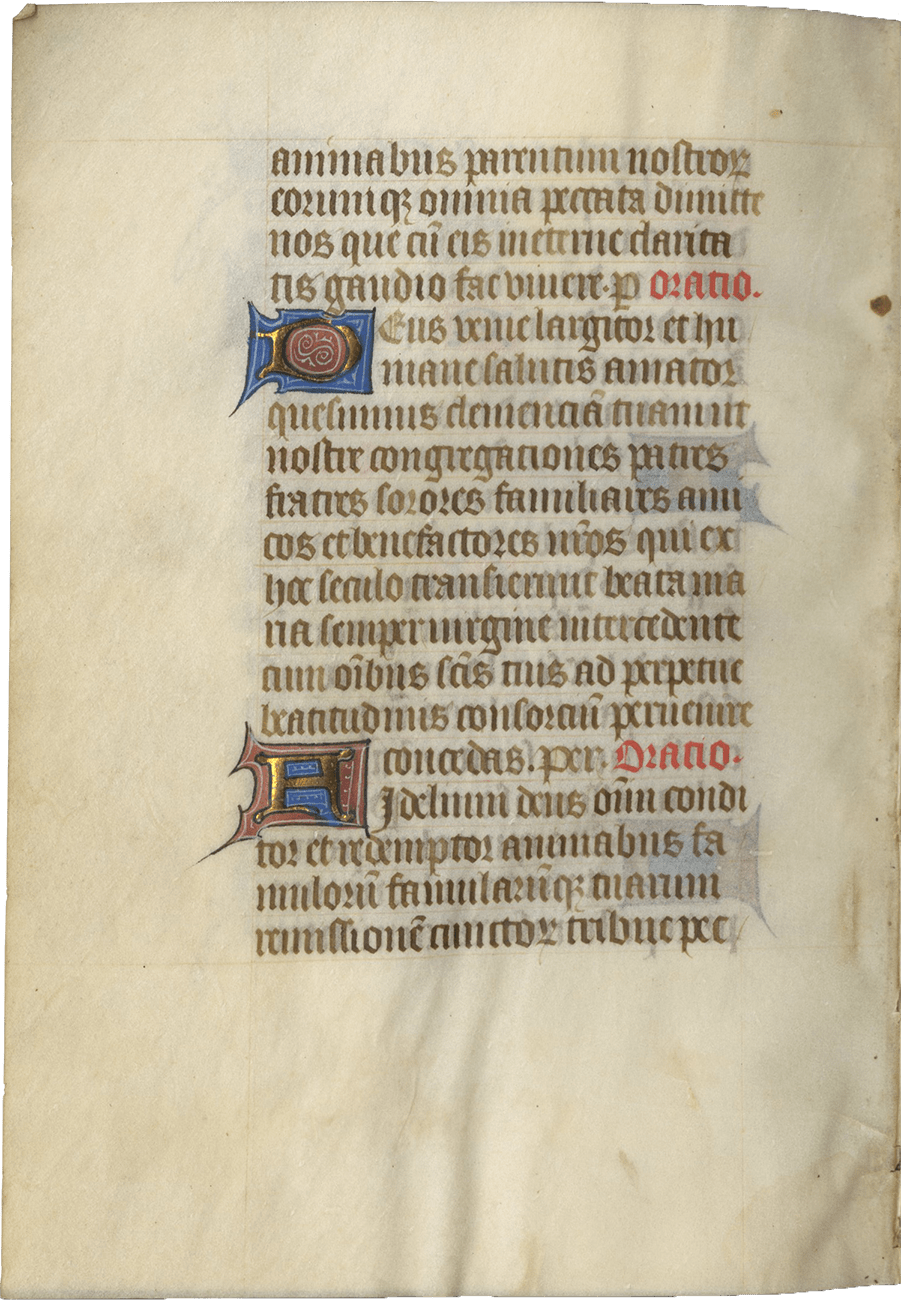
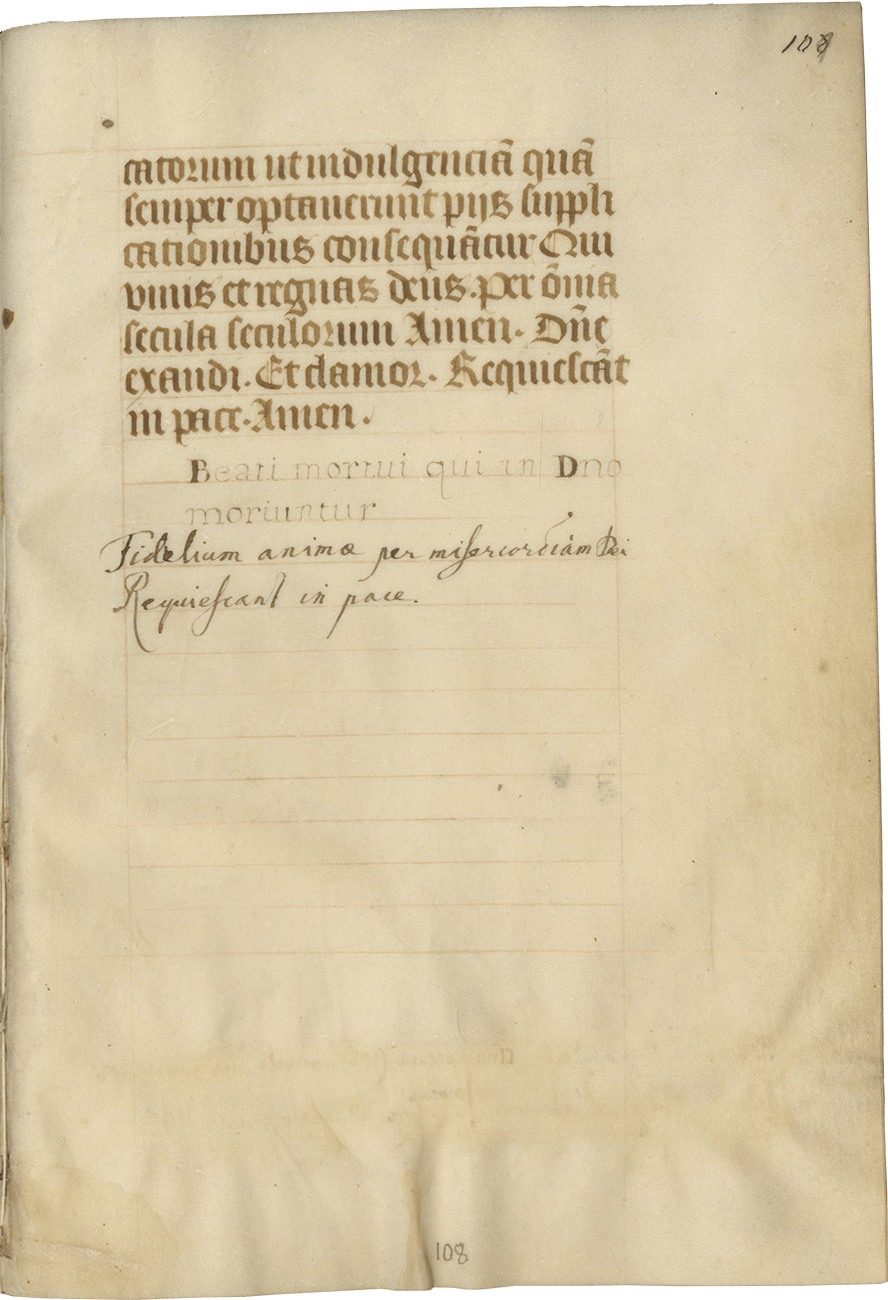
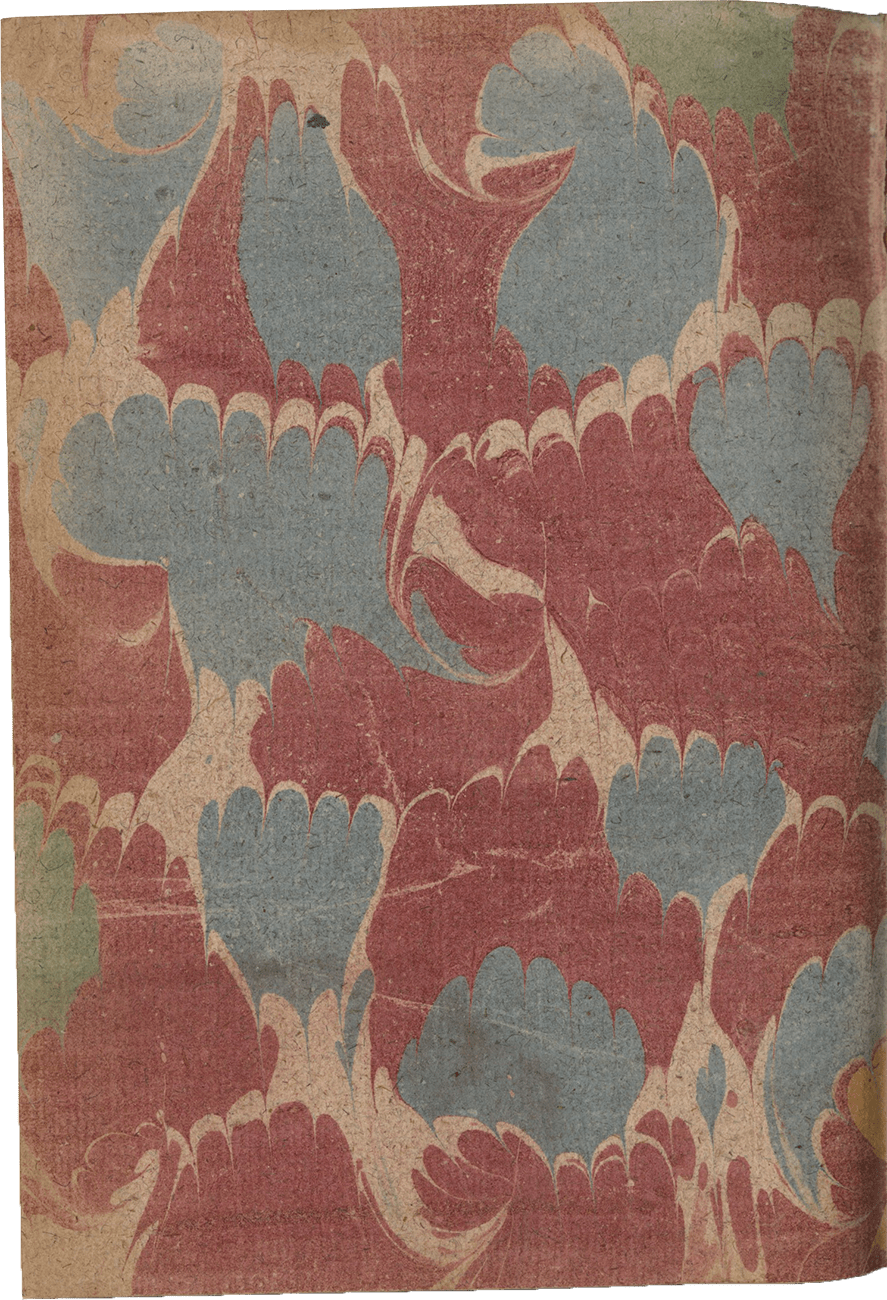

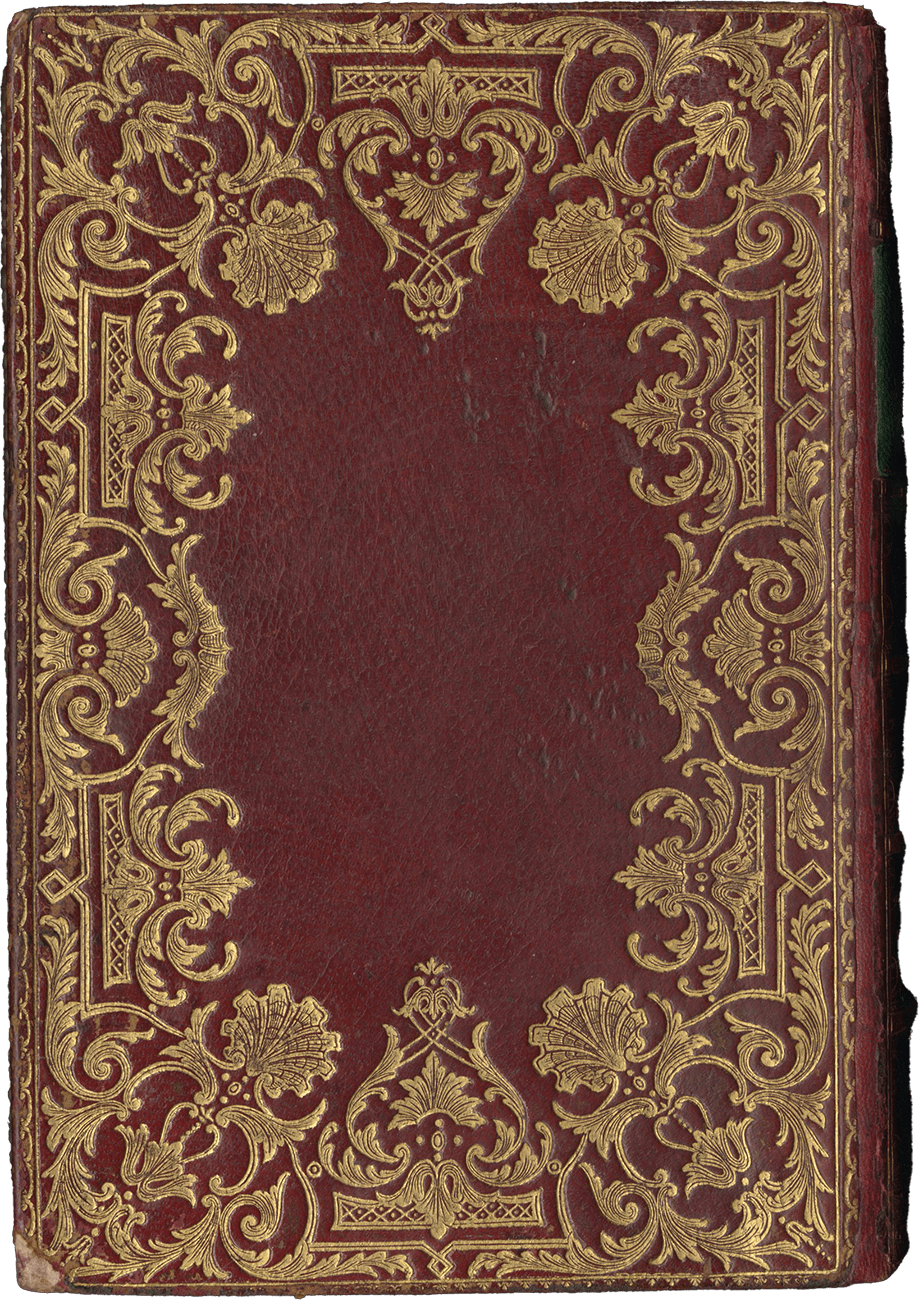
Description
This richly illuminated Book of Hours was tailored to the needs of its patron depicted in prayer in the book: a noble lady most likely named Catherine, member of the house of Haraucourt established near Nancy, Eastern France. Commissioned from the circle of Willem Vrelant, the leading illuminator in the third quarter of the fifteenth century Bruges whose style enjoyed exceptional popularity from the patronage of the dukes of Burgundy, this manuscript shows stylistic features typical of his workshop, such as the preference for narrative details, the intense color scheme, and the elongated figures of stiff attitudes with large heads, pointed chins, and pink flesh-tones.
iii (modern paper) + i (parchment, foliated 1) + 107 + ii (modern paper), foliated in pencil in a modern hand in top outer corner, 1-108, lacks two leaves with miniatures, else complete [collation: i6, ii10+1-1 (singleton with miniature before f. 8), iii6, iv2+1 (f. 26 added), v2, vi8+1 (f. 29 added), vii-ix8, x4, xi8+1-1 (singleton with miniature before f. 66), xii8+1 (f. 79 added), xiii-xiv8, xv8+1 (f. 107 added), xvi2], ruled in red for one column of 19 lines, written in brown ink in a formal gothic bookhand, capitals touched with yellow, rubrics in red, one-line initials alternately in burnished gold on blue penwork or blue on red penwork, two-line initials in burnished gold on alternately red and blue ground with white tracery, TWELVE SIX-LINE HISTORIATED INITIALS in red on blue ground, framed with gold, with white tracery, each accompanied with a three-sided border of gold dots, acanthus sprouts, and colored flowers, THREE SMALL MINIATURES accompanied with a three-sided border of the same, FOUR FULL-PAGE MINIATURES framed with red and burnished gold, accompanied with a full-page floral border of the same, and facing a five-lines illuminated initial in blue on burnished gold ground, in-filled with flowers, associated with a full-page floral border of the same, including on two openings a total of FOUR SMALL MINIATURES depicting a female donor in prayer, as well as two coats of arms (slight browning at the edges, slight cockling of the parchment, occasional stains, else in very good condition). Bound in an eighteenth-century red morocco gilt-tooled binding in the style of Derome le Jeune, spine raised on five bands, title-piece tooled “Heures Manuscrit” in green leather, pastedowns in marbled paper (spine rebacked, scuffs at corners, slight soiling, else in good condition). Dimensions: 183 x 130 mm.
Provenance
1. This manuscript was illuminated in Bruges for a female member of the family of Haraucourt, which was established near Nancy, Lorraine. Their coat of arms blazoned or a cruss gules, on a quarter argent a lion sable armed and langued gules crowned or, appears twice in the borders of the manuscript, ff. 8 and 26v. The location of the family’s fiefdom elucidates the choice of a liturgical use of Toul, for Nancy, capital city of the duchy of Lorraine, belonged to that diocese. The repeated depiction of a lady seen in prayer before a prie-Dieu in both margins of the St. Catherine and Annunciation miniatures indicates that it was commissioned by an as-yet unidentified lady of the House of Haraucourt, named Catherine. The rare depiction of St. Bernard of Baden in the suffrages, canonized in 1481, and stylistic evidence suggest that the manuscript could have been illuminated in the early 1480s..
2. A pair of as-yet unidentified coats of arms were illuminated in the sixteenth or seventeenth century on the verso of the first parchment flyleaf, facing the calendar.
3. The manuscript was owned by Joseph Louis in 1761, likely in France, according to a rubbed handwritten inscription on the second flyleaf.
4. Count Grigori Alexandrovitch Stroganoff (1770-1857), governor general of Moscow, art historian, archaeologist, collector, and philanthropist, his print bookplate with motto “Terra mopes patriae sibi nomen” affixed on the first marbled flyleaf.
5. Natalie Hays Hammond (1904-1985), artist, writer, and inventor; the manuscript was exhibited at the Hammond Museum, South Salem, New York.
6. Deaccessioned by the Hammond Museum and purchased on 13 April 1988 by:
7. Scott Schwartz, New York, his MS 29, according to his book label on the front pastedown.
Text
ff. 2-7, Calendar, in brown and red;
ff. 8-12v, Hours of the Cross;
f. 13v, blank, not ruled;
ff. 18-21, Obsecro te, feminine form;
ff. 21-22v, O Intemerata;
ff. 23-28, Suffrages, including St. James, St. Sebastian, St. Nicholas, St. Bernard (Margrave) of Baden -Baden (died in 1458 and was beatified in 1481), St. Mary Magdalen, St. Catherine, St. Barbara and All Saints;
ff. 28v-29, blank, ruled;
ff. 30-65v, Hours of the Virgin (use of Toul), with Lauds, f. 37v, Prime, f. 44v, Terce, f. 48v, Sext, f. 50v, None, f. 54v, Vespers, f. 57, Compline, f. 61v;
ff. 66-73, Penitential Psalms;
ff. 73v-78v, Litany and Prayers, including many local saints from the region of Toul, such as Gengulf, Arnulphe, Amane, Mansuete, Aper
f. 79, blank, not ruled;
ff. 80-109, Office of the Dead (use of Toul).
Illustration
4 full-page miniatures, as follow:
f. 13v., Pentecost;
f. 26v., St. Catherine, with a coat-of-arms and two small miniatures of a lady in prayer in the borders;
f. 29v., Annunciation, with two small miniatures of a lady in prayer in the borders;
f. 79v., Funeral service.
3 small miniatures and 12 historiated initials, as follow:
f. 18, Pietà (initial O);
f. 23, St. James (initial O);
f. 23v., St. Sebastian (initial O);
f. 24, St. Nicholas;
f. 24v., St. Bernard Marchio of Baden-Baden (initial O);
f. 25, St. Mary Magdalen;
f. 27v, St. Barbara;
f. 28, All Saints (initial O)
f. 37v., Visitation (initial D);
f. 44v., Nativity (initial D);
f. 48v., Annunciation to the Shepherds (initial D);
f. 50v., Adoration of the Magi (initial D);
f. 54, Presentation in the Temple (initial D);
f. 57, Massacre of the Innocents (initial D);
f. 61v., Flight into Egypt (initial C).
The extensive illumination of this Book of Hours includes four full-page miniatures due to a member of the circle of Willem Vrelant, the leading illuminator active in Bruges from at least 1454 until his death in 1482. The figures are distinguished by elongated bodies and stiff attitudes, as well as large heads with combed hairs, pointed chin, and pink flesh-tones. Other stylistic features typical of Vrelant include an overall appetite for narrative details, a taste for intense and varied colors often used in stark contrasts, as well as a predilection for plain blue acanthus and gold disks in the floral borders. Most of the models used for these miniatures and initials also derive from manuscripts associated with his workshop and circle. An example is the interior setting of both the Annunciation and the Pentecost, which relies on the same models used in a Book of Hours from Vrelant’s workshop (Baltimore, Walters Art Museum, MS W.184, ff. 23v and 36v; fig. 1).
The illuminator of the full-page miniatures of the Haraucourt Hours can be distinguished by a taste for rapidly defined facial features, often shaded in a thin brushstroke rather than drawn. This modelling could be compared, for instance, to a Book of Hours for the use of Sarum now in Cambridge (Fitzwilliam Museum, MS 53; fig. 2). The historiated initials and small miniatures, on the other hand, present a rounded modelling with broader facial features that are much more typical of Willem Vrelant’s workshop production, and find close comparisons with the historiated initials of several such manuscripts in Baltimore (Walters Art Museum, MS W.168; MS W.202; fig. 3).
Willem Vrelant was born in Utrecht, possibly in Vreeland, and is recorded as an illuminator in Bruges from 1454 to 1481. Payment records from 1468 and 1469 attest that he worked on two different commissions for the dukes of Burgundy. This patronage may have contributed to his style becoming so popular. Given the popularity of his workshop and its productivity, “it remains difficult,” as Georges Dogaer has observed, “to draw a firm line between the œuvre of the Master and that of his followers” (Dogaer, 1987, p. 99).
Literature
Georges Dogaer. Flemish miniature painting in the 15th and 16th centuries, Amsterdam, 1987.
Bernard Bousmanne. “Item à Guillaume Wyelant aussi enlumineur.” Willem Vrelant: Un aspect de l’enluminure dans les Pays-Bas méridionaux sous le mécénat des ducs de Bourgogne Philippe le Bon et Charles le Téméraire, Brussels and Turnhout, 1997.
Bernard Bousmanne and Thierry Delcourt, eds., Miniatures flamandes, 1404-1482, Paris and Brussels, 2011.